#(which is 6.6 x 10^4 notes/year)
Explore tagged Tumblr posts
Text
I did some math in the tags but TLDR: at current rate, it will take the combined lifespans of 3 million universes to completely delete OP.
We gotta work so much harder!!!!!
please don't reblog this post a devilish temptress tricked me into making it and she placed a hex upon it so that every reblog removes a molecule from my body
#So ok#the universe is currently predicted to end in 100 trillion years#that’s 10^14 years#the universe has only been around a negligible 14-ish billion#so I’m just for simplicity going to say that the universe’s total lifespan is 100 trillion years#in the approximately year and a half since this post was made#this post has gotten 95 thousand notes#if we assume this post continues to gain notes at this same constant rate#(which is 6.6 x 10^4 notes/year)#then when the universe ends#this post will have 6.6 x 10^18 notes.#in order to completely delete OP#we will need to have about 3 million more universes#each one with a constant rate of note accretion for this post#so uhhhh…. yeah. we really need to get on that
123K notes
·
View notes
Text
Following a busy week of Ether futures ETF activity, Eric Balchunas, a Senior ETF Analyst for Bloomberg, shares Ether futures ETF activity flows are off to a slow start. In his report, VanEck Ethereum Strategy ETF (EFUT) is taking an early lead over ProShares with $15.6 million in fund asset inflows. An update on the current status On Oct. 2, the first Ether futures began trading in the US, including EFUT, the Bitwise Ethereum Strategy ETF (AETH), the Bitwise Bitcoin and Ether Equal Weight Strategy ETF (BTOP), and the three funds from Proshares, marking the end to a years-long battle by firms to provide investment vehicles on Ethereum. Ether futures ETFs | Source: X However, following their release, the Financial Times reported a trading volume of $6.6 million on Monday. This may be partly attributed to the trial of FTX founder Sam Bankman-Fried in New York, which began on the same day. Upcoming deadlines to note In a separate post on X, Balchunas goes on to provide an update on the rest of the ETF rulings. Here's latest table, altho I think all delayed now, I'm on road so can't update, but here's the need-to-know: 1) 10/13 is deadline for SEC to appeal Grayscale ruling 2) all spot filings basically delayed till Jan 3) SEC is actively engaging w issuers to fine-tune their filings pic.twitter.com/GZ2dQnrjJG— Eric Balchunas (@EricBalchunas) October 4, 2023 On the need-to-know list on Oct. 13 is the deadline for SEC to appeal the Grayscale ruling, with all spot ETF filings being delayed until Jan. 3. [embed]https://www.youtube.com/watch?v=7Z4yG2PdNGM[/embed] In preparation, the SEC is actively engaging with issuers to keep fine-tuning any active filings.
0 notes
Text
Isamu Rat Diet
I’ve seen too many good web pages disappear (and photobucket is nasty) so I’m reposting the good bits of this RatForum thread here. It’s obviously more pertinent to UK rat owners but can help inform rat owners in other countries, as well.
02-18-2013
Isamurat: Making your own mix – how I do it (picture guide)
I have seen that several people are thinking of starting to make their own mix, or are just starting out feeding one. I thought it might be useful to see how I go about my mix, with photos and info on the kind of ingredients I use as well as the steps I take. I’ve been feeding a homemade mix for years now (started in 2006) and get on very well with it. I do tend to evolve my mix fairly steadily depending on how the rats are doing and new ideas I see. This is one of my mixes, they are all slightly different, but the basic balance stays the same. It is very much my take on a Shunamite style mix, given that I started out on that diet, and have learnt and adapted my mix along the way with a good amount of help from its author over the years. Base (50% by volume) First off I start by assembling the base of the mix, this is predominantly minimally processed grains, it forms about half my total mix and is aimed at giving a solid foundation of carbs, that aren’t too easy to digest (leads to fat rats) and contain plenty of whole grains, but not too much that are high in phosphorous (harsh on the kidneys, one of a rats weak points). I like to include a decent amount of grains still in their husks here too, as it adds an element of enrichment, and keeps the rats busy during the day doing what they are meant to do, peel open little seeds and grains. This means that I generally use animal quality grains (or at least a good number of them) as for some reason us humans are rubbish at, or too lazy to getting grains out of there husks so strip them off. I’ve used a lot of different bases in the past, sometimes entirely mixed grains, sometimes entirely a rat suitable commercial rabbit food. My current balance involves a mix of the two and works well, they get the variety with the backup of the enriched rabbit food. To make my base I add the following (note I’ve tried to photo these all in the same container for people to see the size of the bits) • 6 scoops Banana brunch - this is a lovely rabbit mix with the following ingredients (in order of volume); cooked flaked peas, cooked flaked barley, oats, cooked flaked maize, cooked flaked beans, mixed wheat discs (with vitamins), banana chips, flaked carrot, banana essence, vitamins + minerals. Its nutritional analysis is; protein 14%, fat 2%, fibre 5%, Vitamin A 5000 iu/kg, Vitamin E 26 iu/kg, copper (cupric sulphate) 5mg/kg . I break up the banana pieces into smaller chunks, otherwise it looks like this

• 6 Scoops Marshams Mixed flakes - this is a nice mix of micronize flakes, micronizing is essentially heating and squishing, the heating helps ensure that the fungus issue you sometimes see with dried corn/maize isn’t an issue. It’s 60% flaked barely, 20% flakes peas and 20% flaked corn and smells lovely and pea flavoured. I use this to help bulk out my mix and up the barley content (this is my fave rat kidney friendly grain, closely followed by rice)

• 4 scoops Versa Laga Junior Dark Plus Pigeon mix – I add this as it’s a good way of getting lots of variety of seeds and grains in without having to have many little packets of them. Its ingredients are as follows: extra french cribs maize 16%, dari white 14%, paddy rice 12%, extra wheat 8%, safflower seed 8%, extra small french cribs maize 6%, milocorn 4%, extra barley 4%, yellow peas 4%, green peas 4%, small green peas 4%, yellow millet 2%, toasted soya beans 2%, mungbeans 2%, maple peas 2%, striped sunflower seeds 1%, brown linseed 1%, junior pellet I.C. 6%. Its major nutritional values are; protein 12.5%, fat 7%, fibre 7.5%, carbohydrates 54%. The higher fat helps combat the low fat of the banana brunch and mixed flakes. It’s a lovely interesting mix and goes down well.

• 2 scoops Paddy rice – there’s already some in the pigeon food, however I add more as it’s such a good grain, and my preferred mixes major on barely and rice. Paddy rice is a nice form of rice, it’s still inside it’s husk, meaning to get at the grain the rats need to peel it before they reveal the brown rice inside.

• 1 scoop Pearl Barley – I add this as an alternative form of barley, it’s a different shape and texture so nice for them, this is human quality so unfortunately doesn’t have its husk on, I’ll get hold of some that are husky at some point.

• 1 scoop Millet seeds – this is another good grain, and as it’s around 11% protein it helps make up for the fact that most grains are very low in protein. I get a mixture of red and white millet still in their husks

• 2 x Millet spray broken up – another form/texture of millet. I take a millet spray and just run my fingers along the stalk backwards, giving my lots of mini millet tufts. These are a little easier for rats to find in there substrate, though mine can find even individual seeds now.
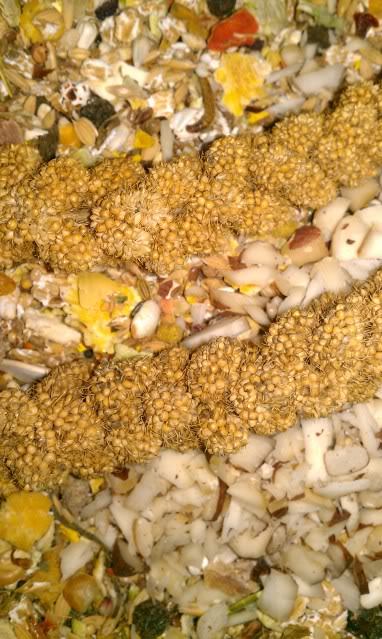
When mixed together this gives me my base mix which is approximately 20-21 scoops
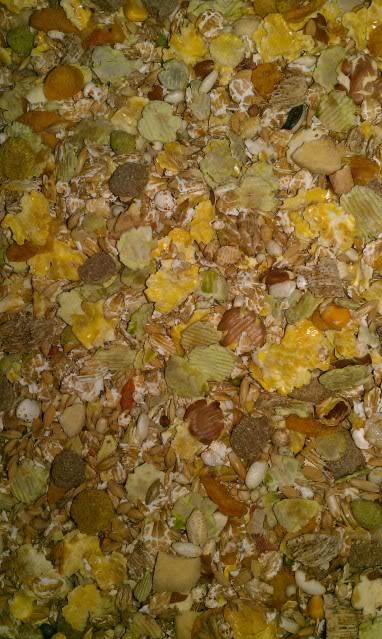
Protein (5-10%)
As I use a base that works out relatively low protein in need to add extra protein to top it up. Rats need a diet around 12-14% protein for normal adults, more for growing youngsters. The best protein sources for being kind to the kidneys are egg, soya and fish (in that order). All have their strengths and weaknesses so I do a mix, which also adds variety balancing there weaknesses. It also helps make sure that the rats get ‘complete’ protein, proteins are made up of different amino acids, you need a full range of them to fully use the protein, mixing the type of protein you use helps this. • ½ scoop dried shrimps, mealworms, fish, tubifex, bloodworm and krill. Crustatians are really handy as there high in copper, they are also a great form of protein in that they have a high protein:fat ratio. Mealworms are a little high in fat but I include them because they’re quite a natural foodstuff for rats, and there isn’t loads of them. These are all very light, as I mix by volume it means by weight I don’t add loads, but given there around 60% protein this is good as you don’t want to boost the overall values too much.

• ½ scoop Soya flakes – this is micronized soya, the cooking part of the process makes it safe for the rats to eat, as uncooked soya beans are not good for them (much like any bean). Soya is a bit controversial for some people, it reduces the chance of some forms of cancer, and increases the chances of others, however pretty much all studies are done at high levels of soya, feeding as a small part of the diet can be quite beneficial and it’s a good kidney kind protein and one of the few proteins which are complete. I’ve also fed it as the dried beans soaked for 12 hours, then roasted in the oven, this also makes them safe to eat (and are a nice treat for humans and rats too).
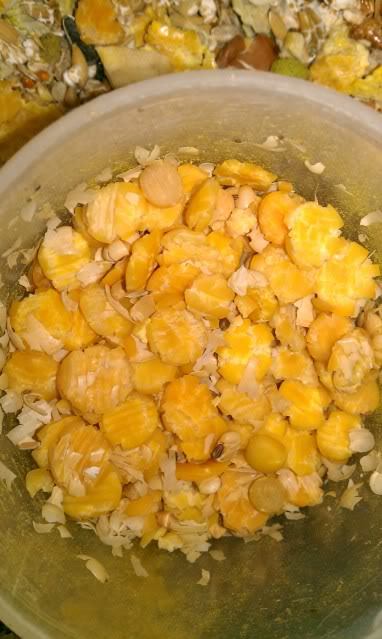
• ½ scoop Egg biscuit– this is essentially floury biscuit soaked in egg then dried. It is often sold for birds as egg food, this one is particularly nice as its in bigger chunks, meaning the rats can find it in their substrate when I scatter feed. It seems a little high in sugar (smells cakey), so I wouldn’t use it as all their protein, but it’s a very handy way of adding dried egg.
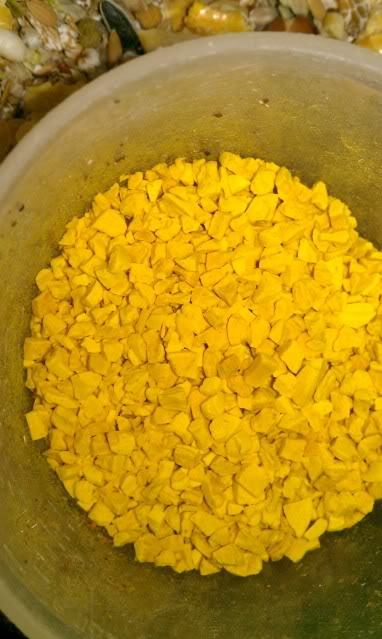
• ½ scoop Fish for dogs Salmon small bite kibble. This is by far my fave dog kibble to use in my rats diet, its really high quality and the ingredients list says it all. Ingredients; Salmon (27%), Pea Flour (22%), Potato (23%), Fishmeal (8.7%), Salmon Oil (9.3%), Beet Pulp (6.6%), Brewers Yeast, Minerals. Nutrition: Protein 26%, Fat 12%, Crude Fibres 7.5%, Omega-3 Fatty Acids 1%, Vitamins: Vitamin D3 1,800 IU; Copper Chelate Of Amino Acid Hydrate 80mg; Calcium Iodate Anhydrous 2.5mg Antioxidants (Stabilised With Rosemary And Tocopherol-Rich Extracts). Effectively it has a good proportion of named meat, and that’s an oily fish, which is a sign of good quality. Also by going for fish you avoid the heavily farmed poultry or beef, which are far more likely to have poor care standards and contain lots of chemicals. The other ingredients are also named and aside from the fishmeal (which I would prefer over most other meat meals) all are whole. The protein is quite high for a dog kibble but as I don’t add loads it works well, plus the size of the pieces is tiny, which means it spreads well in the mix. I mainly add it because of the added vitamins it contains, particularly vit d and copper. Both are naturally low in a grain based mix, and with the rabbit food I add being low copper I need to boost it. This helps a fair bit and as an added bonus the rats love it too
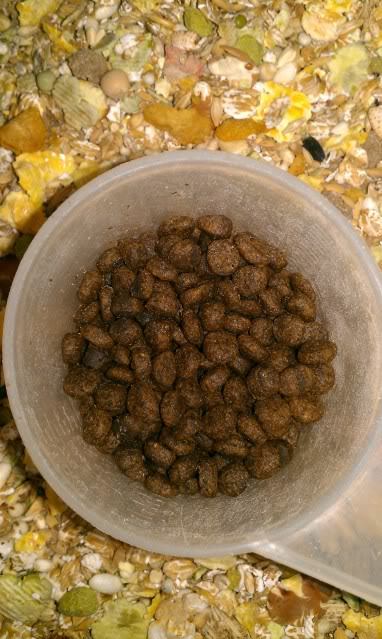
Here’s a shot of the mix with protein element added to the base

Processed Carbohydrates 20-25%
This section is there to up the amount of carbs the rat can get from the food, as well as adding in vitamins and minerals. A diet entirely devoid of more processed carbs can mean that some of the nutrition is not so available. Too high and you get rats that get fat easily. This balance seems to work well, as long as you keep the sugar content of the carbs down below 5% (in most cases) and try and select for wholegrain products unless you have old rats (when white grains, and upping the overall percentage can be useful). • 1 scoop Denes wholegrain mixer – this is a mixer for dogs, it’s a wheat based biscuit, which I normally don’t prefer, but has good vitamin content, especially copper, calcium and vitamin D, so it is very useful. Ingredients: Cereals (Wholegrain Wheat), Derivatives of vegetable origin (herbs include Seaweed), Grassmeal, Minerals. Nutrition: Protein 11%, Oil 2%, Fibre 4%, Calcium 1.4%, Copper (Cupric Sulphate) 15mg/kg, Vitamin A 5,000iu/kg, Vitamin D3 500iu/kg, Vitamin E 50mg/kg. I break these in half of thirds as on their own they are a bit too big to properly divide up in a mix.
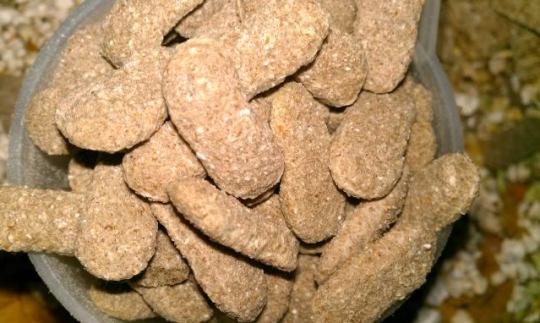
• 1 scoop Rice crispies – one of my preferred grains, I normally go for a value or own brand ranges as they are generally lower in sugar, as a breakfast cereal its enriched with plenty of vitamins and minerals.
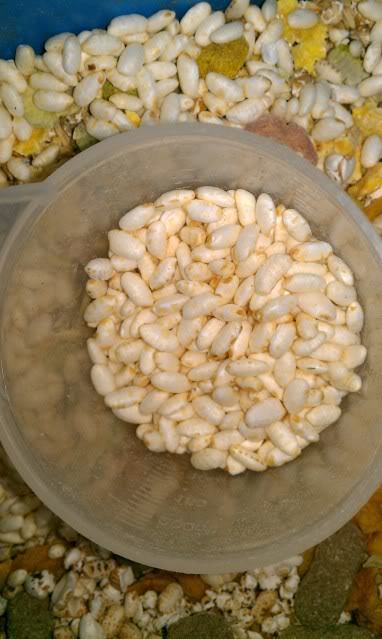
• 1 scoop Mixed puffs – These are a mix of different grains including spelt, rice, millet, etc. These offer a nice easily digestible addition to the diet and add a variety of grains

• ½ scoop Shredded wheat bitesize – this is the lowest phosphorous form of wheat, I break them up a bit and use them as my main wheat element of the mix.

• ½ scoop Cornflakes - similar to rice crispies, I use own or value brands, whatever is lowest sugar content. They are enriched which is handy and corn isn’t a bad grain to have in terms of phosphorous.

• 1 rice cracker broken up – mainly added for a little more variety, I break into small pieces At this stage the mix looks like this

Herbs – 5%
This part of the mix offers extra flavours and textures, as well as a change to exploit some of the lovely properties many herbs have. I vary this one every time and try and add a couple of different types in. I generally use herbs sold for rabbits as they come in decent sized chunks, human herbs are chopped too finely and easily get lost in the mix. • ½ scoop Herb Plus – this is my fave rabbit herb mix, it smells lovely and has good variety in it

• ½ scoop Echinacea – This apparently has immune boosting properties (at least in the tincture form, I doubt it adds much in its herb form, but I feed it anyway), it’s a little big so I chop it up smaller, the rats eat it though it’s not there fave bit.
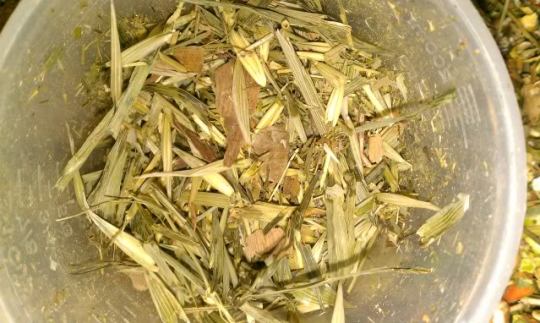
• 2-3 sheets Shredded Nori – seaweed is full of lots of minerals and is very useful to have in a mix, I find that cutting up dried nori sheets sold for sushi goes down well and is easy to get hold of, seaweed powder just gets lost in a mix.

Veg – 5%
This also adds some variety and extra flavours, vits and minerals. • ½ scoop Dried mixed veg – this is a mix typically sold for human soups, its leek, carrot, potato and peas. I sometimes get it in cubes, sometimes chopped for variety of texture.

• ¼ scoop Beetroot flakes – beetroot is a super food, full of all sorts of good stuff, its also a natural way to add colour to the mix (from an entirely human view lol). The rats seem to like it as it’s one of the first things to go. If it gets wet though it turns things near it pink.

• ¼ scoop Mixed pepper flakes – A nice mix of chopped, dried sweet peppers (capsicum), both red and green, colourful veg is packed full of vitamin C and it goes down well too.

At this stage the mix looks like this

Seeds – 5%
This is the final element of my mix, it ups the fat content, as aside from the protein section everything else is a fair bit lower in fat than the rats need. It also makes sure that these fats are good fats, in particular omega 3 and 6. It’s easy to cut out the good fats when your rat is overweight but don’t, the overall calories make a far bigger difference and a decent amount of good quality fats keeps there skin and coat healthy. This section also adds a bit of additional protein to the mix and can have other advantages if you choose your seeds well. • 1 scoop Mixed Seeds and pine nuts – This is a mix of good seeds I’ve made up, I always try and get them in their shells or husks to add to the task of getting in to them, it also slows down there scoffing slightly. This mix includes hemp (one of the few complete protein sources out there), linseed (otherwise known as flax, great for the kidneys), pumpkin seeds in their shells (full of nice omega oils), Pine nuts (there shells are really tough which is a great challenge to the rats), mixed meadow seeds (typically edible grass and flower seeds), fennel seeds (gives them a lovely smell) and cumin seeds. The main ones are the first few oily seeds, with the others adding variety and interest, as well as the challenge of finding them in there bedding.
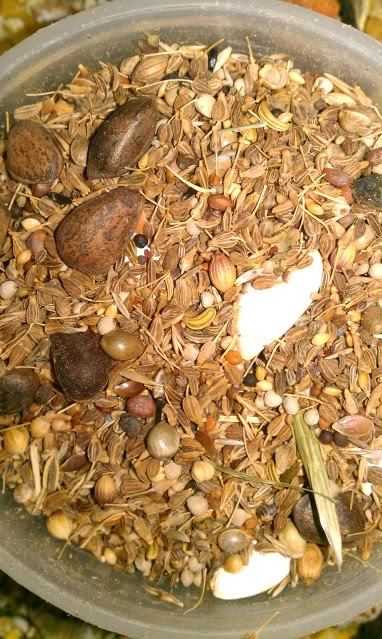
• 6 Chopped brazil nuts - I add these because here in the UK, and in Europe in general, our grains are low in the mineral selenium, brazils are really high in it, so the rats don’t need much. About 1 brazil will do 4-6 rats there selenium intake for a week. I chop them up small so everyone gets a bit of them.
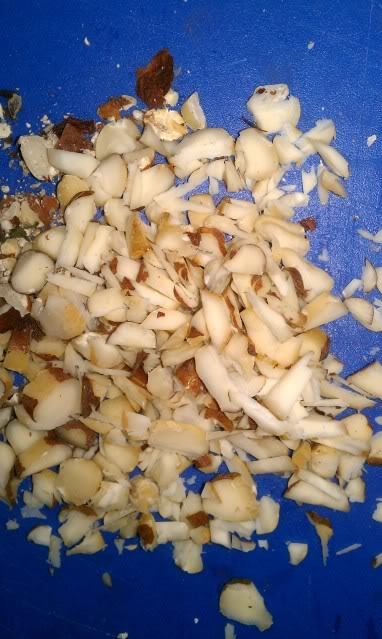
When everything is mixed together it looks like this
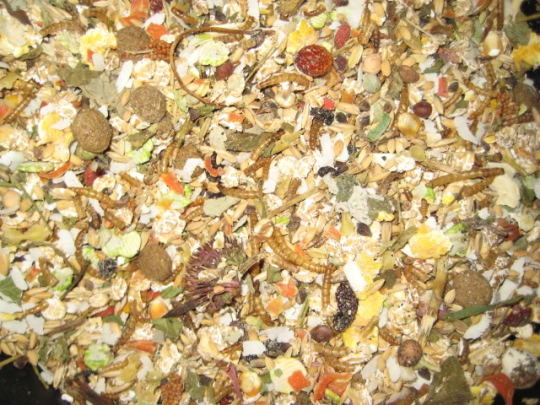
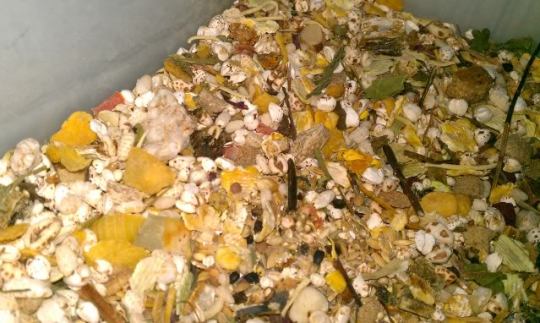
The above mix is fed in the mornings, they get about 10-20g of this mix each a day. Importantly to me it’s scatter fed, which means they have to forage for it in there substrate. It’s not just about what you feed, it’s also how you feed it. They don’t leave anything apart from husks, as I’m mean and don’t feed loads. Supplements, Veg and Fresh Food On its own it is not this mix is not 100% complete, it’s still a bit low on some vitamins and minerals, however I feed it alongside a daily mix of Veg. I also give them vitamin supplements in there water once to twice a week. These are important as the offer a safety net in terms of vitamins and help to make sure everything is covered. Even with all the balancing above, and feeding daily veg the mix is a little weak on copper, vit d and calcium. Without this the rats could become deficient, you can balance it to some extent by fresh, but I would strongly advise anyone who feeds this kind of diet to consider some supplements, having had rats with vit D deficiency in the past when I didn’t add the kibble, rabbit food etc. The following are my normal ‘extra’s • Dr Squiggles Daily Essentials 1 – this has a nice wide range of vitamins and minerals, the main ones I use it for are topping up there copper and vit D. It goes in there water 1-2 days a week, or up to 6 days a week for babies or pregnant mums

• Dr Squiggles Calcivet �� this contains calcium and vitamin D, they get this alongside there daily essentials, I don’t feed this daily, even in youngsters, as the rats need time to process the calcium, so need at least a day off a week, plus too much and they can get calcium stones. 1-3 days a week is plenty for an adult, up to 6 for a baby. • Bones and egg shells – a great source of calcium, my rats always get my left over bones, they get lots of iron out of the marrow , the bones are full of calcium too. Egg shells are the same, they might get 1-2 shells a week, which they sometimes eat. If they get some of these, especially bones, I only do calcivet one day a week • Vegetable – this is fed daily, it’s a mixture of veg I make up then freeze in daily portions. It’s 50% dark green leafy veg such as kale, 20% colourful veg such as carrots, tomatoes or peppers, 20% other veg such as peas, sweetcorn, courgettes etc, 5% berries and 5%raw coconut chopped up. They adore this mix

• Cooked meal – about 1-2 times a fortnight the rats get a balanced cooked meal, this is typically carbs, protein and veg, like eggy rice with peas. It’s a bit of a treat, though a healthy one, and replaces there dry mix for the day. I use it to hide other supplements in and give them a bit of a boost. Typically it has a multivitamin powder in, some salmon or linseed oil and anything else that may be appropriate for their age and conditions (such as extra vit b and glucosamine for oldies, and phosphate binder for those with kidney issues).

Its easy enough to create your own diet based on this kind of principles, a lot is about what ingredients you can get hold of and understanding what the words mean on the ingredients list of things you find in pet shops and supermarkets, but really it’s doable for anyone. I would say that unless you really know how to judge your rats condition make sure you feed a good proportion of enriched foods (like most pet foods and human breakfast cereals) and ideally a good vitamin supplement too, and if your not sure whats wrong talk about it and don’t be afraid to change the balance a little. Someone I massively respect in the rat world once said that feeding rats is part science and part art, and from my experience that is very true. I started out relying on spread sheet and meeting the scientific requirements of my rats, but never got them beyond ‘good enough’ condition, then I relaxed a bit and started doing it more by feel and now my lads are in the best condition they’ve been, which was also verified by others at the show I went to this weekend. Its really nice when it all comes together.
Here’s a list of where you can find them in the UK (I tend to get mine all from online shops, the local farm shop or the supermarket), as well as some info on how to choose alternative brands, as I doubt the same brands are available over there Base • Banana brunch ��� You can get this from some pet shops, online petshops and online small holder / farm suppliers in the UK. When looking for alternatives try and find a rabbit muesli which is higher in peas/barley/beans than wheat and ideally has no alfalfa, wheatfeed or strawfeed added (or these are low down the ingredients list). Don’t just limit yourself to rabbit food, some rat, horse and guinea pig food isn’t bad as a base over here (though it might not be great for a normal meal). If you cant find any you can drop this element of the base, its just a nice cover all. Aiming for around 10-14% protein and 2-5% fat works well • Marshams Mixed flakes – Animal feed stores, online farm/small holding stores, farm and equine supply shops. Its normally easier to get hold of each product individually but that’s not massively practical with only a small number of rats. There are a variety of mixes sold here, the ones higher in barley are better, some come with added soya flakes too, which is handy. This could be replaced to some extent by more processed grains sold in health stores, less enrichment for the rats but easier to get hold of. Can work out quite expensive though and you need to get a range of grains • Versa Laga Junior Dark Plus Pigeon mix – Animal feed stores, online farm/small holding stores, bird feed specialists. if picking an alternative aim for one with a large range of grains and not too high or low protein, most pigeon feeds are predominantly corn, avoid these unless you don’t have much if any corn elsewhere in the mix. Some parrot / bird seed my make a good alternative • Paddy rice – Online bird feed stores, im sure it must be available elsewhere but that’s the only place I’ve found it here, oh and rat rations but as that started out life as an online bird feed store until the rat world got hold of it that doesn’t count. • Pearl Barley – supermarket, health food shop • Millet seeds – bird feed shops, could replace with processed millet if needed or entirely with broken up millet sprays if wanted • Millet spray broken up – pet shops, very commonly sold over here. Protein • dried shrimps, mealworms, fish, tubifex, bloodworm and krill. – sold for turtle/terrapin/fish food here in specialist exotics shops (mainly sourced online). Mealworms are very easy to get hold of and sold for wild birds. • Soya flakes – Animal feed stores, farm shops, online small holder ranges etc., can replace with roasted soya nuts (salt free) which you can make yourself by soaking dried soya beans for 12 hours and roasting for about 20-30 mins at 180 deg C. Chickpeas are another alternative (also need soaking and roasting) as is dried soya mince or similar often sold in health shops • Egg biscuit– sold as bird egg food or similar in some pet shops and bird food specialists. Could be removed and just feed fresh egg once a week. • Fish for dogs Salmon small bite kibble. – found in online petshops and their website, not sure if this brand is available in the US. Look for high end ‘natural ingredients’ dog food, aiming for fish based where possible as its higher quality. High copper content and small bite is a bonus. Can be missed out but you need to up the supplements relatively Processed Carbohydrates • Denes wholegrain mixer – Available from online pet shops, it’s a natural vegetarian mixer. Aim for high end ranges again, look for high vitamin content, especially copper. An alternative is barley rings, sold as animal feed in farm shops, small holder places etc. If your missing this out you will have to up supplements in other forms. • Rice crispies – supermarket • Mixed puffs – health food shops, rat rations (who stock pretty much everything here in the uk) • Shredded wheat bitesize – supermarket • Cornflakes - supermarket • rice cracker broken up – supermarket Herbs • Herb Plus and Echinacea – pet shops, sold as rabbit treats, alternatives is to aim for a nice mix of herbs and edible plants, can do this yourself easily enough, just get a load of fresh herbs, hang to dry on a cooling rack in somewhere warm and dry, break them up. Good herbs and plants to try are; dandelion leaves, current leaves and your commonly available human edible herbs like basil, tarragon, mint etc, Growing your own is easy to do as well. • Shredded Nori – supermarkets, Asian food shops Veg • Dried mixed veg – some supermarkets, online human food shops (sold as soup ingredients, loads of choice out there) • Beetroot flakes and pepper flakes – as above but more specialist so not in most supermarkets, there’s a vast range of options out there, some interesting ones are; kale, cabbage, mushrooms, carrot, berries, tomato etc Seeds • Mixed Seeds and pine nuts – Bird seed specialists online stock a good range of seeds still in there husks, I get pumpkin, hemp, pinenuts and linseed from them, for the others (which are a nice to have) they are sold as a special mix by versalaga for wild birds in the uk (meadow mix) or from Indian / spices suppliers (cumin and fennel), I’ve found them in my local supermarket too. If you’re struggling a human quality seed mix sold by supermarkets is a good option, or look at some of the parrot foods out there, though try and avoid those too heavy in sunflower seeds and peanuts. • brazil nuts - supermarkets (probably not needed in the US) Supplements, Veg and Fresh Food • Dr Squiggles Daily Essentials 1 and Dr Squiggles Calcivet – - bird suppliers, pet shops, mainly online. There are a lot of alternatives out there, though bird supplements seem best for calcium and vitamin d in particular. You can also use those sold for humans, such as vitamin A extracted cod liver oil (here in the Uk the brand seven seas does a good one that does several rat doses when fed once a week in a wet meal) for both of those. Copper is easily fixed by feeding liver regularly, you can make liver treats which make a good way of topping rats up (let me know if you want the recipe). I also add ground up human supplements for vitamin d and calcium to these, baking destroys some of the nutrients but not all. Its always worth looking at other animals supplements too, some are very useful for rats, some of the senior dog ones are very handy for old rats in particular for example. • Bones and egg shells – left overs, alternatively here in the UK butchers will often give you free or very cheap bones for dogs, you can roast these or even feed raw in many cases. • Vegetables – supermarket, some fresh, some ready frozen, • Cooked meal – whatever’s in the house, mainly carb with some healthy protein, bit of oil and any veg I’ve got or some natural wet dog food, fish for dogs do a nice salmon mousse that’s great as a treat for the boys. I’m sure you can find similar quality stuff in the US, the trick is read the ingredients, if there’s any you don’t recognise then it’s probably not great quality. If anyones not sure of anything then if you can get it's ingredients and nutrition and bung it on here myself or someone else thats spent a bit of time on rat nutrition will probably be able to help.
It probably works out around £2.50per kg, which is cheaper than anything decent here in the uk. My rats get about 60g a day (I have 5 boys) so it works out roughly £5 a month, then theres veg and such on top. That is down to buying some stuff in bulk from farm shoos though, as I have sone local friends I split it with.
Oh and it keeps pretty well in a good container, as long as the oldest ingredient. Normally I make up monthly batches and keep the unmixed stuff in a sealed box in my shed. This lasts typically 6 months
It evolved over the years. Next time you make yours just try adding a couple ingredients or changing a few whilst keeping the balance the same. over time your mix will develop to. To be honest mine had changed since this again lol, I've found a bit more banana brunch seemed to improve my boys coat, and oddly less veg to (though they still get it a couple times a week). out just goes to show that you can play around to find the right food for your rats if you know how to judge condition
9 notes
·
View notes
Text
iPhone XS – Wikipedia
Sharengay Trang Tin Tức Độc Đáo VIDEO iPhone XS – Wikipedia
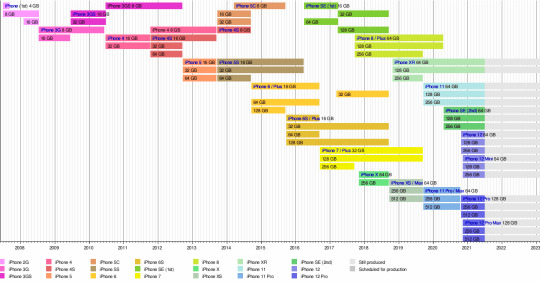
iPhone XS iPhone XS Max
iPhone XS Max in Silver
Brand Apple Inc. Manufacturer
Foxconn[1] (on contract)
Slogan Welcome to the big screens. Generation 12th Model XS: A1920 A2097 A2098 (sold in Japan) A2100 (sold in China) XS Max: A1921 A2101 A2102 (sold in Japan) A2104 (sold in China) Compatible networks GSM, CDMA2000, EV-DO, HSPA+, LTE, LTE Advanced First released September 21, 2018; 2 years ago Availability by region
September 21, 2018
Bạn đang xem: iPhone XS – Wikipedia
Australia
Austria
Belgium
Canada
China, Mainland
Denmark
Finland
France
Germany
Hong Kong
Ireland
Italy
Japan
Mexico
Netherlands
New Zealand
Norway
Portugal
Saudi Arabia
Singapore
Spain
Sweden
Switzerland
Taiwan
United Arab Emirates
United Kingdom
United States
September 28, 2018
Andorra
Armenia
Azerbaijan
Bahrain
Bulgaria
Croatia
Cyprus
Czech Republic
Estonia
Georgia
Greece
Greenland
Hungary
Iceland
India
Kazakhstan
Kuwait
Latvia
Lebanon
Liechtenstein
Lithuania
Malta
Monaco
Morocco
Nigeria
Oman
Poland
Qatar
Romania
Russia
Serbia
Slovakia
Slovenia
South Africa
October 18, 2018
Israel
October 26, 2018
Belarus
Chile
Colombia
Malaysia
Peru
Philippines
Thailand
November 2, 2018
South Korea
November 9, 2018
Brazil
November 30, 2018
Xem thêm: NHỮNG MẸO VẶT HÀI HƯỚC NHẤT QUẢ ĐẤT! 😂
Turkey[2]
December 14, 2018
Indonesia
Vietnam
Discontinued September 10, 2019; 21 months ago Predecessor iPhone X Successor iPhone 11 Pro / iPhone 11 Pro Max Related iPhone XR Type XS: Smartphone XS Max: Phablet Form factor Slate Dimensions XS: H: 143.6 mm (5.65 in) W: 70.9 mm (2.79 in) D: 7.7 mm (0.30 in) XS Max: H: 157.5 mm (6.20 in) W: 77.4 mm (3.05 in) D: 7.7 mm (0.30 in) Mass XS: 177 g (6.2 oz) XS Max: 208 g (7.3 oz) Operating system Original: iOS 12.0 Current: iOS 14.6, released May 24, 2021 System on chip Apple A12 Bionic CPU Hexa-core (2x high power Vortex cores at 2.49GHz + 4x low power Tempest cores at 1.52 GHz) Modem Intel PMB9955 (XMM7560[a]) Memory 4 GB LPDDR4X[8] Storage 64, 256 or 512 GB Removable storage None Battery XS: 3.81 V 10.13 W·h (2658 mA·h) Li-ion XS Max: 3.80 V 12.08 W·h (3174 mA·h) Li-ion Display XS: 5.85 in (149 mm), 2436×1125 px, supplied by Samsung Dispaly XS Max: 6.46 in (164 mm), 2688×1242 px, supplied by Samsung Display[9] All models: 458 ppi, Super Retina: Custom-built OLED HDR, true blacks, wide color gamut, 625 cd/m² max. brightness (typical), with dual-ion exchange-strengthened glass and 3D Touch Rear camera 12 MP (1.4 μm) (1/2.55″) Sony Exmor IMX333-Inspired, quad-LED flash, ƒ/1.8 aperture, Optical image stabilization (both wide-angle & telephoto) quad-LED flash, autofocus, IR filter, Burst mode, 6-element lens, 4K video recording at 30 or 60 FPS or 1080p at 30 or 60 FPS, Slow-motion video (1080p at 120 FPS or 240 FPS), Time-lapse with stabilization, Panorama (up to 63 megapixels), Portrait Mode, Portrait Lighting, Face detection, Digital image stabilization, Dual Optical image stabilization, Stereo audio recording Front camera 7 MP, f/2.2 aperture, burst mode, exposure control, face detection, auto-HDR, auto image stabilization, Retina flash, 1080p HD video recording
Portrait Mode, Portrait Lighting, and Animoji (Same as iPhone XR)
Sound Stereo speakers Water resistance IP68, up to 2 m (6.6 ft) for 30 minutes Other FaceTime audio- or video-calling, Qi wireless charging, USB-C to Lightning (connector) fast charging Hearing aid compatibility M3, T4[10] Website iPhone XS – Apple at the Wayback Machine (archived September 9, 2019) References [11][12]
The iPhone XS and iPhone XS Max (stylized and marketed as iPhone Xs and iPhone Xs Max; Roman numeral “X” pronounced “ten”)[13][14] are smartphones designed, developed and marketed by Apple Inc. They are the twelfth-generation flagships of the iPhone, succeeding the iPhone X.[15] Apple CEO Tim Cook announced the devices alongside a lower-end model, the iPhone XR, on September 12, 2018, at the Steve Jobs Theater at Apple Park. Pre-orders began on September 14, 2018, and went on sale on September 21.[16]
The XS Max was the first plus-sized iPhone to have the newer bezel-less form factor, as the iPhone X did not have a larger variant. Production of the iPhone XS (and XS Max) ceased on September 10, 2019, after the iPhone 11 and 11 Pro announcement. On January 20, 2020, Apple started selling certified refurbished models starting at $699.
Design[edit]
The iPhone XS has a design visually near-identical to the iPhone X but includes upgraded hardware, featuring the A12 Bionic chip built with a 7 nanometer process.[17] It also features a 5.85 inch (149 mm) OLED display (marketed as 5.8 inch) with a 2436×1125 resolution at 458 ppi and contains dual 12-megapixel rear cameras and one 7-megapixel front-facing camera. The iPhone XS Max features the same hardware and cameras, but has a larger 6.46 inch (164 mm) OLED display (marketed as 6.5 inch) 2688 x 1242 resolution at 458 ppi and battery (3,174mAh).[18] It was also noted by the media that the XS received a smaller battery than that of the X (dropping to 2,658 mAh from 2,716 mAh).[19] The XS’ battery is a new single-cell L-shaped battery, while the iPhone XS Max battery remains two cells like the iPhone X.[20] Additionally, Apple states that the iPhone XS lasts up to 30 minutes longer than iPhone X, while the iPhone XS Max lasts up to 1.5 hours longer than iPhone X.[21]
Color Name Silver Space Gray Gold
Apple claims that the devices have faster Face ID technology than the iPhone X.[22] It was also announced in June 2019 at WWDC that Face ID on iPhone XS, iPhone XS Max, iPhone XR and iPhone X would be made up to 30% faster with iOS 13, which was released on September 19, 2019.[23]
The XS and XS Max are rated IP68 for dust and water resistance under IEC standard 60529, with Apple specifying a maximum depth of 2 meters and up to 30 minutes of submersion in water.[24] This is an improvement over the IP67 water resistance of the iPhone 8 and X.[25] Apple has performed tests in various liquids including chlorinated water, salt water, tea, wine, beer and juices.[26]
The XS and XS Max support dual SIMs through a nano-SIM and an eSIM. In mainland China, Hong Kong, and Macau, however, the XS Max comes with a dual nano-SIM tray (and no eSIM). The XS does not have a dual nano-SIM tray, so the eSIM functionality is enabled for use in Hong Kong and Macau, but not in mainland China.[27][28][29]
The wireless charging coil material was switched to copper to reduce charging time and power loss.[30][31]
Rear camera upgrades[edit]
iPhone cameras, starting with the iPhone 6S, had a 12MP (1/2.94″) sensor size with a 1.22 μm pixel size.[32][33]
Xem thêm: Galaxy S10e, S10, and S10+ enterprise edition
The iPhone XS, XS Max and XR are the first ones to record stereo audio for videos.[34]
Starting with the iPhone 2018 lineup (iPhone XS, iPhone XS Max and iPhone XR), these cameras were updated to a 12MP (1/2.55″) sensor size with a 1.4 μm pixel size,[35] the same sensor and pixel size as the primary cameras of the Samsung Galaxy S10,[36] Samsung Galaxy S9[37] Samsung Galaxy S8[38] Samsung Galaxy S7,[39] Pixel 2,[40] Pixel 3a and Pixel 3a XL,[41] Pixel 3 and Pixel 3 XL.[42] Moto X4.[43]
Reception and issues[edit]
Reception and connectivity issues[edit]
The iPhone XS received generally positive reviews from critics after release. iPhone XS and XS Max users initially had issues with LTE, Wi-Fi reception and Bluetooth connections. Some experts claimed that a faulty antenna was to blame,[44] and in response to many consumer complaints about iPhone XS/XS Max connectivity problems, Apple contacted users for help with their investigation.[45] To resolve some problems with the XS/XS Max, Apple pushed the iOS 12.0.1 update on October 8, 2018, which, along with addressing the Chargegate issue, fixed a connectivity issue where Bluetooth could become temporarily unavailable on the XS/XS Max.[46]
Charging issues (Chargegate)[edit]
Users reported problems charging the iPhone XS and XS Max with a Lightning cable, where the device would fail to charge if it had been off for a while, and would only begin to charge if the screen was turned on.[47] This would occur due to a software bug with Apple’s “Disable USB accessories when locked” setting, a feature intended to prevent unknown devices from accessing a user’s content within an iPhone. The press dubbed the issue “Chargegate”.[48][49][50][51][52] This issue, along with Bluetooth connectivity problems, was resolved with the release of iOS 12.0.1 on October 8, 2018.[53]
Excessive smoothing in selfies (Beautygate)[edit]
Customers have also reported seeing unrealistic smoothness on their skin when taking a selfie by an automatic filter.[54] Observers have noted that this face-smoothing effect is likely (and unintentionally) caused by the new Smart HDR camera feature on the XS and XS Max. This technology combines multiple photos of varying exposures to increase dynamic range on the iPhones’ photos, but can also lead to less pronounced facial imperfections and decreased highlights in selfies. Some speculated this was the result of a hidden “beauty mode” (an actual feature in some smartphones) and dubbed the issue “Beautygate.” There was a general dispute in the community as to whether the camera actually “intended” to “perfect” faces or if they just appeared that way as result of a better quality camera.[55]
Apple said that these results were due to the Smart HDR algorithm incorrectly selecting the blurrier long exposure as its base frame instead of the sharpest short exposure. The issue was resolved with the release of iOS 12.1 on October 30, 2018.[56][57]
Timeline of iPhone models[edit]

See also[edit]
Comparison of smartphones
History of iPhone
iPhone XR
List of iOS devices
Notes[edit]
^ The chip marked PMB9955 is believed by many sources to be an XMM7560.[3][4][5][6][7]
References[edit]
^ Fingas, Roger. “Foxconn taking charge of vast majority of iPhone production this fall”. AppleInsider. Retrieved September 12, 2018.
^ “iPhone XS, iPhone XS Max ve iPhone XR’ın Türkiye çıkış tarihi belli oldu”. Hürriyet (in Turkish). November 23, 2018. Retrieved October 14, 2020.
^ Srivatsan Sridhar. “Apple iPhone XS and iPhone XS Max teardown reveals Intel Gigabit LTE modem, notched battery for XS, Apple power management IC for XS Max”. https://bit.ly/3qUg6xm.
^ “iPhone XS Max Review – The New Way of Life – Compare Phones”. Compare Phones. Archived from the original on October 2, 2018. Retrieved October 2, 2018.
^ Daniel Yang & Stacy Wegner. “Apple iPhone XS Teardown”. https://bit.ly/3dM6JKO.
^ Abazovic, Fuad. “iPhone XS has Intel modem inside”.
^ “iPhone XS and XS Max Teardown”. iFixit. September 21, 2018.
^ Hardy, Ed (September 13, 2018). “Geekbench scores reveal RAM upgrades in new iPhones”. Cult of Mac. Retrieved September 18, 2018.
^ Tillman, Maggie (December 12, 2018). “Apple to use new Samsung OLED display”. Pocket-link. Retrieved June 27, 2021.
^ Apple (September 12, 2018). “About Hearing Aid Compatibility (HAC) requirements for iPhone – Apple Support”. Apple Support. Retrieved October 8, 2018.
^ “Apple iPhone XS – Full phone specifications”. https://bit.ly/3yqF0au. Retrieved September 21, 2018.
^ “Apple iPhone XS Max – Full phone specifications”. https://bit.ly/3yqF0au. Retrieved September 21, 2018.
^ “It’s pronounced ‘iPhone Ten’ “. The Verge. Archived from the original on October 10, 2017. Retrieved October 10, 2017.
^ “You’re pronouncing the iPhone X wrong”. News.com.au. Retrieved December 12, 2018.
^ Gurman, Mark. “Apple unveils big, $1,099 iPhone XS Max and pitches upgraded Apple Watch as health device”. latimes.com. Retrieved September 13, 2018.
^ Hern, Alex (September 12, 2018). “Apple launches iPhone XS, XS Max and XR – as it happened”. The Guardian. Retrieved September 12, 2018.
^ Kastrenakes, Jacob. “New iPhone XS and huge 6.5-inch XS Max announced”. The Verge. Retrieved September 12, 2018.
^ “iPhone XS, XS Max, XR specs: Battery size, RAM details revealed in new filings”. PCMag. Retrieved September 20, 2018.
^ Kelly, Gordon. “Apple’s iPhone XS Has A Nasty Surprise”. Forbes. Retrieved September 23, 2018.
^ Rossignol, Joe. “iFixit: iPhone XS Has ‘Notched’ Battery and iPhone XS Max Has Apple-Designed Power Management Chip [Updated]”. https://bit.ly/3ykOgNd. Retrieved January 28, 2019.
^ “iPhone XS – Technical Specifications”. Apple (United Kingdom). Retrieved August 1, 2019.
^ Miller, Chance (September 12, 2018). “iPhone Xs & iPhone Xs Max feature faster Face ID performance, Apple claims”. 9to5Mac. Retrieved November 18, 2018.
^ “iOS 13 Preview – Features”. Apple. Retrieved August 1, 2019.
^ “iPhone XS – Technical Specifications”. Apple. Retrieved September 20, 2018.
^ Crook, Jordan. “Apple introduces the iPhone Xs and iPhone Xs Max”. TechCrunch. Retrieved September 12, 2018.
^ Hall, Zac (September 12, 2018). “iPhone Xs and iPhone Xs Max announced: 6.5-inch model, new gold finish, much more”. 9to5Mac. Retrieved November 18, 2018. iPhone Xs and iPhone Xs Max are splash- and water-resistant rated IP68 and protect against everyday spills including coffee, tea and soda.
^ iPhone XS – 技术规格. Apple (in Chinese). Retrieved September 16, 2018.
^ “iPhone XS – Technical Specifications”. Apple. Retrieved September 16, 2018.
^ iPhone XS – 技術規格. Apple (in Chinese). Retrieved September 16, 2018.
^ Rossignol, Joe (August 20, 2018). “2018 iPhones May Feature Faster and More Efficient Wireless Charging With Switch to Copper Coil”. MacRumors. Retrieved November 18, 2018.
^ “iPhone XS improvements to Qi wireless charging limited to efficiency, not voltage increase”. AppleInsider. September 18, 2018. Retrieved November 18, 2018.
^ “Apple iPhone SE Teardown”. https://bit.ly/3dM6JKO. Retrieved March 14, 2019.
^ “Apple iPhone 7 Teardown”. https://bit.ly/3dM6JKO. Retrieved March 14, 2019.
^ GSMArena review of the iPhone XS video camera
^ “iPhone XS and XS Max Teardown”. iFixit. September 21, 2018. Retrieved March 14, 2019.
^ “Samsung Galaxy S10 and S10e Teardown”. iFixit. March 6, 2019. Retrieved June 1, 2019.
^ “Samsung Galaxy S9 Teardown”. iFixit. March 9, 2018. Retrieved March 14, 2019.
^ “Samsung Galaxy S8 Teardown”. iFixit. April 17, 2017. Retrieved June 1, 2019.
^ “Samsung Galaxy S7 Teardown”. iFixit. March 8, 2016. Retrieved June 1, 2019.
^ “Google Pixel 2 XL Teardown”. iFixit. October 19, 2017. Retrieved June 1, 2019.
^ “Compare Pixel 3a Tech Specs – Camera, Battery & Size – Google Store”. store.google.com. Retrieved June 1, 2019.
^ “Compare Pixel 3 Tech Specs – Camera, Battery & Size – Google Store”. store.google.com. Retrieved June 1, 2019.
^ “moto x (4th gen.)”. Motorola. Retrieved June 1, 2019.
^ Andrew J Shepherd. “[UPDATED] iPhone XS and XS Max mostly fail to impress in lab-tested RF power output”. Retrieved January 28, 2019.
^ Clover, Juli. “Apple Looking Into LTE Connectivity Issues Affecting Some iPhone XS and XS Max Owners”. https://bit.ly/3ykOgNd. Retrieved January 28, 2019.
^ “About iOS 12 Updates”. Apple Support. Retrieved January 28, 2019.
^ “Apple silent amid iPhone ‘chargegate’ complaints”. BBC. October 1, 2018. Retrieved October 5, 2018.
^ “Apple silent amid ‘chargegate’ complaints”. BBC News. October 1, 2018.
^ Belam, Martin (October 1, 2018). “iPhone XS and XS Max: ‘chargegate’ sees some devices fail to charge”. the Guardian.
^ “Apple has revealed a fix for its huge charging problem”. The Independent.
^ JAMES HETHERINGTON (October 1, 2018). “Less than two weeks after launch, the iPhone XS and XS Max have a major problem”. Newsweek.
^ Antonio Villas. “Some iPhone XS owners are reporting that their new iPhones have problems charging”. Business Insider.
^ “Apple’s iOS 12.0.1 update fixes slow reception, charging issues on iPhone XS”. The Verge. Retrieved October 17, 2018.
^ “Some people are saying Apple’s new iPhone selfie camera automatically smooths your skin in photos — and they’re calling it ‘beautygate’ “. Business Insider. Retrieved October 6, 2018.
^ “iPhone XS beauty-gate”. cnet.
^ Kelly, Gordon (October 23, 2018). “Apple Quietly Admits To iPhone Selfie Issue”. Forbes. Retrieved November 18, 2018.
^ Patel, Nilay (October 23, 2018). “Apple iPhone XR review: better than good enough”. The Verge. Archived from the original on November 15, 2018. Retrieved November 18, 2018. Apple told me that the forthcoming iOS 12.1 update, currently in public beta, will address the issue of the front camera appearing to smooth out skin by picking a sharper base frame for Smart HDR, but I wasn’t able to test it yet.
^ Apple Inc. (2007–2020). iPhone News – Newsroom Archive. Retrieved July 23, 2020.
External links[edit]
iPhone XS – official site
v
t
e
Apple hardware since 1998
Consumer desktop, all-in-ones
eMac
iMac
G3
G4
G5
Intel-based
Apple silicon
Mac Mini
Professional tower, desktops
iMac Pro
Mac Pro
Power Macintosh
G3
G4
G4 Cube
G5
Xserve
Consumer laptops
iBook
MacBook
2006–2012
2015–2019
MacBook Air
Intel-based
Apple silicon
Professional laptops
MacBook Pro
1st
2nd
3rd
4th
5th
PowerBook
G3
G4
Consumer electronics
Apple TV
1st
2nd
3rd
HD
4K, 2017
4K, 2021
Apple Watch
1st generation
Series 1
Series 2
Series 3
Series 4
Series 5
Series 6
SE
Displays
Thunderbolt
Cinema
Studio
Pro Display XDR
HomePod
HomePod Mini
iPad
1st
2
3rd
4th
2017
2018
2019
2020
iPad Mini
1st
2
3
4
5th
Air
1st
2
2019
2020
iPad Pro
1st
2nd
3rd
4th
5th
iPod
Classic
Photo
Mini
iPod+HP
Shuffle
Nano
Touch
Newton
MessagePad
eMate 300
Smartphones
iPhone
2G
3G
3GS
4
4S
5
5C
5S
6, 6 Plus
6S, 6S Plus
SE (1st)
7, 7 Plus
8, 8 Plus
X
XS, XS Max
XR
11
11 Pro, Pro Max
SE (2nd)
12, 12 Mini
12 Pro, Pro Max
Accessories
AirPods
1st
2nd
Pro
Max
AirPort
Express
Extreme
Time Capsule
AirPower (cancelled)
AirTag
Headphones
with Remote
Earphones
with Remote and Mic
EarPods
with Lightning Connector
In-Ear Headphones
iPad
Pencil
1st
2nd
Magic Keyboard for iPad
iPod
Click Wheel
Nike+
iPhone Stereo Headset
iSight
Keyboard
Wireless
Magic
Mouse
USB
Pro
Wireless
Mighty
Magic
Magic 2
Remote
Siri Remote
Speakers
Hi-Fi
SoundSticks
SuperDrive
Trackpad
Magic
Magic 2
USB Modem
Xserve RAID
Italics indicate current products. See also: Apple hardware before 1998
Nguồn: https://sharengay.online Danh mục: Đời Sống
iPhone XS – Wikipedia
from Sharengay Trang Tin Tức Độc Đáo VIDEO https://bit.ly/3dISMx7 via IFTTT
0 notes
Text
How the world's six largest economies are faring amidst the global political economy of COVID-19
New Post has been published on http://khalilhumam.com/how-the-worlds-six-largest-economies-are-faring-amidst-the-global-political-economy-of-covid-19/
How the world's six largest economies are faring amidst the global political economy of COVID-19
Together, these six nations represent 44 per cent of the world’s population
Coronavirus image concept of medical face mask and money, representing the pandemic and economic damages by Jernej Furman on Flickr, CC BY 2.0.
By Ian Inkster On September 6, 2020, officially recorded cases of COVID-19 surpassed 27 million, with a mortality of over 884,000 people. Although we are still in the midst of this global pandemic, thoughts are increasingly turning to its ultimate economic impacts. Here we show that the economic impress of the virus in any nation will be closely related to the extent of virus cases and mortality and the condition of the economy prior to the endemic, as well as to virus management policies. The political economy of any one nation, however, is interlinked with the global economy, and because of this the scale of activities in the largest economies really does matter—they may even be of greater importance to a nation’s ease of recovery than the effectiveness of its COVID-19 management regime. Table 1 below lists the six major economies by GDP, noting overall COVID-19 incidence since the inception of the virus. Row A shows cases per million, Row B shows deaths per million, and Row C shows deaths per number of cases in each nation. Together, these six nations represent 44 per cent of the world’s population (E), 42 per cent of COVID-19 cases (D), and 57 per cent of global GDP—so they are of tremendous importance in all respects. It is immediately clear that the crude total of cases (Row D) says nothing much about real impacts. India, for instance, has a huge number of cases but a much smaller ratio of cases/population than the USA or the UK. Indeed, Britain—with far fewer total cases than India—has a disastrous statistical record: the largest number of deaths per million and by far the largest ratio of deaths to cases (Row C), often termed the “observed case mortality ratio”, at over 12 per cent compared to Japan’s 1.9 per cent. Germany, usually seen as exemplary in the West, in fact has a much greater case mortality ratio than Japan or India. Things are not quite what they seem when compared to the “spike talk” and abrasiveness of the Western press, in particular.
Poverty, Age, and COVID-19
Table 2 moves towards an interpretation of this data. First, the poorer the nation as measured by per capita purchasing power parity income (that is, World Bank data) the lower the incidence and morbidity of COVID-19. Moving along Row F, India has a per capita income of only 13 per cent of the USA, 15 per cent of Germany's, or 18 per cent of Japan's. Yet the presence of COVID-19 in India, despite headlines of alarm, is far lower. Rows G and H explain this substantially. In an income-poor nation such as India, the population of youngsters 0-19 years old (G) is very high, at 35.7 per cent, compared to 17.2 per cent in Japan or 17.7 per cent in Germany. As the virus has little impact on the young, this substantially reduces the proportion of the population subject to infection in India. Again, the very low percentage of elderly people (Row H, 6.6 per cent) compared to each of the other five nations is startling. Germany’s 22.2 per cent means that death per capita there should be much higher than in India by a multiple of 3 or 4, as COVID-19 results in mortality among the elderly far more than among younger age groups. Even in China, where Maoist population control reduced births, focused on smaller families and achieved longer survival amongst the elderly, the age differentials based on low income do possibly explain the China's good COVID-19 performance—we do not have to believe Trumpist rhetoric about lying and mischievous Chinese authorities.
The advantages of relative poverty
The other elements of Table 2 that act as advantages for India and China compared to the other four nations centre on much lower urbanism, lower air pollution, and more distant borders (Rows J-M). Row J shows emissions of carbon dioxide, methane, nitrous oxide, perfluorocarbon, hydrofluorocarbon and sulphur hexafluoride per capita in metric tons. The combination of high air contamination with very high degrees of urban living in the richer of the six nations is a possibly potent factor in transmission and severity of the virus, although research on this is ongoing. Again, in the poorer large nations, the table shows long borders, but these are distant from urban centres and sparsely populated in the main. In contrast, the USA has considerable borders in dense settlement regions adjacent to other high-COVID-19 nations—Canada with 3,479 cases per million, Mexico with its 4,372 cases per million. The life expectancy results in Row P spell out the effects of low income and low health expenditures—Indian life expectancy being 15 years and more below that of Japan. So, while the lack of health funding in the low-income nations (with Row N showing USA spending 20 times as much and 4 times the proportion of its GDP, in comparison to India) is a depressing global fact, it is not sufficient to raise infection or morbidity levels of COVID-19 in comparison to those of the rich nations of this group.
Complexities, political economy of COVID-19
Table 3 below turns to the likely economic impacts of COVID-19 following our overall analysis. The biggest factor in recovery will probably be the extent of COVID-19 spread. Thus, Japan and the UK have almost identical incomes per capita, (Table 3, Row Q) but Japan has a far lower incidence of COVID-19 (Table 1, Rows A-C), less than one-quarter of British cases, a tiny fraction of its observed case fatality ratio. We can expect an easier Japanese recovery. On the other hand, generalising across the board, several other factors are involved in any economic forecasts, as suggested in Table 3. Row T shows different rates of GDP in the six nations in post-recession years, and, other things being equal, the fast-growing China and India have a better running start on recovery. Their lower levels of national debt (Row R) means that they might have more public-funding slack—that is, growth will reduce debts from “recovery spending. At the same time, these two nations have a greater opportunity to borrow public funds through increasing their national debts. In contrast, Japan has a very high existing national debt (R) but low COVID-19 presence, so might be able to trade her way out of imminent funding problems—Row S, showing that, as with Germany, Japan has a surplus on her export-import trade balance (e+i%). Trade will be crucial. Row Y shows a high mutual dependency on trade in this group—the calculation here shows the number of the six nations listed as within the top four importing/exporting nations of the nation concerned; a figure of 0 would indicate minimum dependency, a figure of 4 the maximum. The figures of 2 and 3 throughout this row, therefore, show a high dependency of trade within the group—severe trade failure as a result of slow COVID-19 recovery in any members will demonstrably impact on the others. So, the large nations, in a pessimistic scenario, could well lead the rest of the world into further economic recession through a fall in their trading activity outside the group. This is highlighted when we focus on the US and China as trading nations, bearing in mind that the total Chinese economy is growing much faster than that of the US (Row T). In 52 of 64 major economies globally, China is ranked in the top 4 as an exporter or importer to them. In 33 cases China is the major origin of their imports. China imports 10 per cent less than it exports, and has been growing very rapidly for some time. In contrast, the USA has a smaller world impact, trading disproportionately across her own borders with Canada and Mexico, or with China and Japan. The USA imports 20 per cent more than it exports, and its GDP has been growing at a rate of around 30 per cent of that of China. Crucially, the proportion of Chinese imports that go to poorer, non-industrial nations is around twice that of the USA. We may conclude that although severe trade decline would affect all nations, severe Chinese decline would be very serious for a much greater array of nations, and especially so for poorer or developing countries.
Constraints on policy choices
Finally, the political dimension can only be surmised. Rows W, X, and Z provide something approaching a measure of a comparative political economy for the six nations. The HDI, or human development index, of the United Nations incorporates life expectancy, education and incomes, and Row X adds the degree of income inequality between nations—the lower the figure the greater the equality. India suffers badly here from its low HDI position, which would hamper longer-term recovery from COVID-19. Surprisingly, given the range of political systems in this group, levels of equality/inequality are nothing to boast about but are relatively similar. So, these nations would have difficulty driving forward economic recovery programs that dampened the high levels of HDI, and at the same time—as shown in Row Z—they have very strong positions of political and economic freedom as measured by Freedom House earlier in 2020. As indicated by “*”, all nations other than China are defined as “electoral democracies,” with Germany and Japan leading in this regard. China is the odd nation out.
Six nations and global recovery
The conclusion is awkward. This immensely influential portion of our COVID-19 world has suffered more than average from the virus, has managed this in very varied ways, mostly problematic, and is economically highly interrelated. The US recovery is likely to be slow and hard to predict, in that it suffers hugely from COVID-19, has a low rate of economic growth, and, as Rows X and Z of Table 3 suggest, Freedom House has reason to identify the USA as leading a decline in liberal democracy and the “functioning of government, freedom of expression and belief, and rule of law.” This judgement was made just prior to the COVID-19 outbreak. India might well be a contrast, with a faster recovery due to lower COVID-19 impacts and advantages stemming from all the elements listed in Table 2. A speedy recovery in China together with reasonable growth in India could be the leading optimistic combination—they both have fast rates of growth in the recent COVID-19 past, and they are complementary traders. China, in particular, impacts a wider range of less-developed nations than does the US or the other Big Six nations. In addition, China has political room to move—no electorate complaining of declining democracy, a very low degree of political freedom as defined by Freedom House, (Row Z), so an ability to push through determined programs for recovery and open trade. Finally, in this very complex situation, we might find that the US-China trade war changes in tone, from a simple dualism to a general division between US pressure for global protectionism and a Chinese insistence on global free trading.
Professor Ian Inkster is a global historian and political economist at SOAS, University of London, who has taught and researched at universities in Britain, Australia, Taiwan and Japan. He is the author of 13 books on Asian and global dynamics with a particular focus on industrial and technological development, and the editor of History of Technology since 2000. Forthcoming books are Distraction Capitalism: The World Since 1971, and Invasive Technology and Indigenous Frontiers. Case Studies of Accelerated Change in History, with David Pretel. Follow him on Twitter at @inksterian.
Written by Guest Contributor
0 notes
Text
5 Best phones under 20000 in India

Years after years it is the mid-range segment which is seeing increment. The phones are becoming more capable and are sharing features from their flagship series. There are phones which are having flagship-level hardware and there are phones which inherits few features from the flagships.
This is one of the most popular segments of smartphones. If you are thinking to buy a smartphone in the mid-range segment. Here we have tailored just for you the top 5 mobiles under 20000.
The smartphones offered by Realme, Xiaomi, Vivo offers big value for money in this segment but lacks brand value. While brands like Samsung and Motorola doesn’t offer much in this segment but they do have a good brand value and reliability.
5 Best Phones Under 20000
Below are the 5 best smartphones under 20000 and then we have a few honorable mentions as well. All of these smartphones are pretty good and can handle the day-to-day task with ease.
1. Xiaomi POCO X2
We all know POCO the sub-brand of Xiaomi. It is one of the most loved brands in this segment ever since it launched back in 2018. The POCO X2 is powered by a Snapdragon 730G processor coupled with 6 or 8 GB of RAM. The phone has a beautiful 6.67 inches of LCD display with a 120 HZ of refresh rate. The display also has HDR 10 support.

The phone has a massive 4500 mAh battery which can be charged by a 27W fast charger that comes inside the box. It has a Glass back and to protect the POCO X2 is equipped with Corning Gorilla Glass 5 at the front and at the back as well.
POCO also offers splash resistant though not any official IP rating but some amount of protection is not bad. The POCO X2 has Quad 64 MP camera setup at the back and a dual-camera setup in the front. The Phone starts at ₹16,000 and goes up to ₹20,000 for the top-end variant.
2. Realme 6 Pro
Realme 6 Pro was launched in March 2020. It is one of the best in class phone featuring some of the class-leading features like a display having 90 HZ of refresh rate, fast charging and much more. The phone runs on Snapdragon 720G processor coupled with 6 or 8 GB of RAM. It has a 6.6-inch Full HD+ display with a 90 Hz of refresh rate.
The phone has a 4300 mAh of battery which can be fully charged in under an hour with its 30W fast charger that comes in the box.

Realme 6 Pro has a Quad camera setup at the back having 64 MP main sensor along with an ultra-wide, telephoto, and a macro lens. At the front, it also has a dual-camera setup featuring a wider field of view.
The phone supports dual Sim + MicroSD card slot. It has a nice gradient finish at the back which looks very beautiful. The phone starts at a price of ₹17,999 and goes up to ₹19,999 for the top-end variant featuring 8 GB of RAM and 256 GB of storage.
3. Samsung Galaxy M31
Samsung has really been trying hard to push some good phones in the budget segment of smartphones. Samsung’s M series is the result of it. It is competing pretty good with the other phones in the segment despite lacking some features which others are offering.
It is the brand value that is keeping up the Samsung’s game. The key feature of M31 is the massive 6000 mAh battery and a Quad 64 MP camera setup at the back.

The phone has 6.4 inches of super AMOLED display which looks stunningly beautiful. it is powered by Exynos 9611 and earlier it came with 6 GB of RAM but recently Samsung announced it’s 8 GB variant as well. The phone runs on Android 10 on top of One UI 2.0.
The phone has a plastic back and has a gradient finish which looks good. At the front, the display is protected by Corning Gorilla Glass 3. It comes with a 15W of the fast charger in the box which could be a bit slow to charge the massive 6000 mAh battery if we compare to what the rivals are offering.
The phone has 64 or 128 GB of storage option available and can also be expanded via a micro-sd card. The phone starts from ₹16,999 for the base variant and goes all the way up to ₹19,999 for the top 8 GB 128 Gb storage variant.
4. Xiaomi Redmi Note 9 Pro Max
The Xiaomi’s latest phone from the segment is the Redmi Note 9 Pro Max. A few years ago Xiaomi was the king of this segment but now the competition is very much strong with the likings of Realme, Oppo, and Samsung. In our list of 5 best phones Under 20000, this one is the latest phone as it was launched in May 2020 only.
The Note 9 Pro Max has a massive 5020 mAh battery. The phone runs on Snapdragon 720G coupled with 6 or 8 GB of RAM. It has a massive 6.67 inches of 1080p LCD display with a centre camera cut-out for the selfie camera.

The phone runs on Android 10 based on MIUI 11 out of the box and will be upgraded to the MIUI 12. It has a glass back which is protected by Corning Gorilla Glass 5 and similar protection can be seen in the front as well.
The phone has a Quad camera setup at the back consisting of a 64 MP main camera followed by an ultra-wide, Telephoto, and a 5 MP macro lens. At the front, unlike its rivals, the Redmi Note 9 Pro Max features a single 32 MP camera for selfies. The phone starts at a price of ₹16,500 and goes up to ₹19,999 for the top-end variant.
Also Read: Redmi Note 9: Price, specifications and features
5. Realme X2
The Realme X2 is the younger sibling of the more powerful X2 Pro. The phone has a clean design and is powered by a snapdragon 730G processor coupled with 4, 6 or 8 GB of RAM. This is the only phone in the list that has an under-display fingerprint scanner.
The phone features a beautiful 6.4 inches of 1080p display. The phone has a 4000 mAh of battery which Realme advertises that it can go from 0 to 67% in just 30 mins while using its 30w VOOC charge.

The X2 is protected by Corning Gorilla Glass 5 at the front and at the back as well. It looks beautiful from the back in its gradient colour options. The phone supports DUAL sim and a dedicated micro-sd card slot.
It runs on Android 10 based on Realme UI 1.0. The phone has a Quad camera setup at the back featuring a 64 MP main camera supported by an ultra-wide, depth and a macro lens. At the front, it has a single 32 MP shooter to click selfies. The phone starts at a price of ₹17,999 and goes up to ₹20,999
Final Verdict
For final verdict, our pick is the Realme 6 Pro and the POCO X2 as they both offer similar specifications and the devices look very much promising and future proof. The Honorable mentions goes to the Realme X and Samsung Galaxy A50s.
More to read:
Best Android Smartwatch 2020
Best Android Tablets to Buy in 2020
Best Smartphones with Qualcomm Snapdragon 865 SoC
The post 5 Best phones under 20000 in India appeared first on Androidical.
from https://ift.tt/3eD1iMG
0 notes
Text
Smartphone vs tablet today

Introduced in January 2010, the Apple iPad with the Apple A4 opened the post-PC era of mobile electronic devices. In fact, the Apple A4 was designed as SoC for tablets, smartphones and ipods based on a single core ARM Cortex-A8 processor clocked at 776 MHz (iPod Touch 4G), 800 MHz (iPhone 4) or 1000 MHz (iPad 1). Traditionally, the early years were accompanied by a rapid increase in their popularity with enthusiastic forecasts of great prospects. Probably, some remember the events of this period, the list of which includes: - March 2, 2011 - iPad 2 with a 10-hour battery and two cameras.
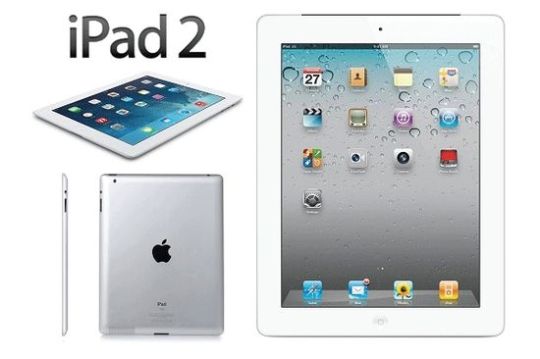
- March 25, 2011 - iPad falls into the Guinness Book of Records as the fastest-selling device in history; - March 7, 2012 - the new iPad with Retina display; - January 2014 - more than 500,000 iPad apps on the App Store; - Fall 2019 - iPad sales exceeded 450 million for the entire period.
Prices for smartphone vs tablet
As the first emotions subsided, the new segment stabilized and occupied a marketing niche between large-screen smartphones and traditional laptops. After increasing screen sizes in flagship smartphones, many experts predicted a quick decline in the tablet segment. But today these forecasts are not confirmed. Indeed, today the market offers a wide range of smartphones with a fairly large screen. For example, today a list of 6.6-6.9-inch relatively inexpensive frameless smartphones includes: - 6.9" Xiaomi Mi Max 3 - from $ 200; - 6.59" Honor 9X and Huawei P smart Z - about $ 250; - 6.7" Samsung Galaxy A70, 71, 80 and Note 10 Lite - $ 320 - $ 520. But flagships are significantly more expensive: - 6.67" OnePlus 7T Pro - $ 800; - 6.57" Honor View 30 Pro - $ 800; - 6.59" ASUS ROG Phone 2 - from $ 900; - 6.58" Huawei P40 Pro - $ 950; - 6.7" Samsung Galaxy S20 plus - $ 1,200; - Samsung Galaxy Fold with two screens, including 7.3" with 2152 x 1536 resolution and Samsung DeX mode (desktop OS interface with Windows 10) - from $ 1,400.

At the same time, the cost of 10.5" Samsung Galaxy Tab is only $ 650, and the price of 10.8" Huawei MatePad Pro with the most powerful 8-core Kirin 990 does not exceed $ 600.

Thus, tablets continue to significantly benefit in price. In addition, the advantage in screen size remains at about 30%. Moreover, tablets are much more effective in solving many problems.
Functionality
1. Compared to a bulky 17-in laptop or 7-in smartphone, the tablet is much more convenient for web surfing, watching videos and other Internet content. 2. The tablet completely replaces the laptop while traveling. In addition, unlike most laptops, the SIM-card slot provides inexpensive mobile Internet. 3. The tablet is very convenient as an electronic photo album. 4. The tablet perfectly replaces the e-book reader. Of course, its screen is inferior to the E-Ink display without backlighting, but it supports the display of graphs and schemes in color. 5. A separate keyboard extends the tablet functionality to a laptop.

6. The stylus and a huge number of apps for creating raster and vector graphics transform the tablet into an effective working tool for artists, designers, photographers, etc. 7. Tablets have long been a convenient tool for doing business. 8. Of course, the tablet is great for a child. Unfortunately, quarantine has created a huge problem for schooling. As a result, distance learning is becoming one of the main alternatives to solving it. Today, the market offers a huge number of educational services, including ABCmouse, Reading eggs, Starfall, etc.

Of course, the smartphone is absolutely not suitable for this purpose because of the screen size. Prolonged use of such a screen tires the eyes of even an adult. Especially, this is unacceptable for children during the formation of vision. Of course, a powerful desktop PC with a large display solves this problem, but not all children today have it. In this case, the tablet can be an excellent budget alternative to solving this problem.
Key Features
Compared to a laptop, a tablet PC uses a simpler OS, does not have a keyboard, but is more portable and has a touch screen. In addition, many models support telephony with SIM cards. Conventionally, modern models can be classified as follows: - Slate PC with Windows OS; - Web tablet with built-in sensor and high-quality wi-fi module based on Android, iOS, webOS, Blackberry or MeeGo; - Transformer with the ability to connect QWERTY-keyboard; - E-book for reading with a monochromatic screen. Basically, functionality depends on several factors, including: - the presence of a stylus for handwriting; - the battery capacity; - processor performance, type and amount of memory affect the support of resource-intensive programs; - cameras; - support for navigation and some other options. Main OS - Android supports a huge number of apps, Google Play and other services from Google. The list of its pros also includes ease of connection and compatibility with other devices; - Windows has its own app store and supports Microsoft Office, which is convenient for many managers and retail agents. Unfortunately, the sensor quality and the assortment of apps are inferior to competitors; - iOS designed for iPad. High quality and a huge number of apps, including iTunes, are its main pros. The list of cons includes a high price, complicated settings and paid apps; - Amazon for Kindle Fire provides high quality, but does not support Google services.

Specs
The 7" models lose their main advantage over smartphones. The 10" tablets are much more popular, but they are less portable. The 1280 × 800 and higher resolution is the most popular today. Of course, a lower resolution reduces energy consumption and, accordingly, increases the battery life. Unfortunately, this also increases eye fatigue. Modern tablets use 4-core or 8-core processors, and RAM from 2 GB and above. The internal memory for films, games and apps should be from 16 GB and above. Of course, memory cards and cloud storage will also be useful. For communication, modern models use Wi-Fi, 3G or 4G LTE. «Wi-Fi Onlу» is suitable only for home use. 2x-band Wi-Fi in the 802.11ac standard is the most convenient. Budget models often use a 2000-3000 mAh battery. Of course, a 5000mAh battery is much more convenient. The latest Bluetooth version, USB or MicroUSB cards significantly expand the tablet usability. Modern tablets are usually used fairly simple 2 MP or 5 MP cameras for Skуpe.
Some popular 2020 tablets
1. Lenovo Tab M10 LTE

Pros: - the price is about $ 200; - high quality assembly; - 10.1" IPS screen with 1920 × 1200 resolution and 224 ppi; - good performance; - Tupe-C in the charger. Cons: - only SMS messages without telephony; - low battery life in the resource-intensive apps. 2. Xiaomi MiPad 4

Pros: - an 8-in screen with 1920 × 1200 resolution and an IPS-matrix (16×10 aspect ratio) provides excellent color rendering; - multi-touch function; - the 8-core Qualcomm Snapdragon 660 (2200 MHz) and the Adreno 512 video card easy support even resource-intensive games; - last Android version; - 13MP and 5MP cameras; - 6000 mAh battery; - compact and lightweight; - USB connection to external devices. Cons: - only 8-in screen; - no phone and GPS mode (GPS support only in version with LTE module); - fast battery discharge; - a too bright screen is inconvenient for reading. 3. Huawei MediaPad T5 10 16Gb LTE

- 8-core HiSilicon Kirin 659 (2360 MHz); - 10.1″ TFT IPS screen with 1920 × 1200 resolution; - phone mode; - 5100 mAh battery; - 5MP with AF and 2MP cameras; - high quality sensor; - GPS with support for A-GPS; - last Android version; - high quality communication; - many apps; - 2 stereo speakers provide high quality sound. Cons: - OS with apps requires an additional memory card; - relatively large weight.
Conclusions
Forecasts about the displacement of tablets by smartphones from the market were exaggerated. Tablets continue to compete confidently in their segment. Moreover, the rapidly growing demand for distance learning due to quarantine opens up additional prospects for these devices. Probably buying a tablet will be redundant if the child already has a powerful desktop PC. Otherwise, the tablet can be a great alternative solution, giving the child access to a huge number of distance educational services. This video offers a comparison of Huawei MatePad Pro vs iPad Pro 2020. Read the full article
#ABCmouse#HiSiliconKirin659#HuaweiMatePadPro#HuaweiMediaPadT5#iPadPro2020#LenovoTabM10LTE#Readingeggs#SamsungGalaxyTab#Starfall#XiaomiMiPad4
0 notes
Text
Best superfast 5G Mobile phones: Galaxy S10 5G, OnePlus 7 Pro 5G, Moto Z4 & more
On Aug. 7, Samsung unveiled three more phones that it's adding to its already-crowded Galaxy lineup: the Note 10, Note 10 Plus and Note 10 Plus 5G. The announcement marked the first time the company has split its Note phone into two sizes, and it revealed Samsung's second 5G phone, following the Galaxy S10 5G, which is available on US carrier Verizon. But Verizon and other major US carriers aren't the only ones readying themselves for 5G. Carriers around the world are ramping up to deliver the latest generation of cellular tech. Not only will these networks connect users to a superfast mobile network, but many other industries will benefit from the faster connectivity of 5G as well, like self-driving cars, drones and the internet of things, to name a few. Though none of these networks are ready for a nationwide rollout currently, carriers everywhere are racing to lay the necessary infrastructure to roll out a faster and more expansive wireless network. As such, more and more 5G deployment will take place throughout this year and next. Right now, 5G is live in select cities for Verizon, T-Mobile, AT&T, and Sprint users. And in Britain, UK carrier EE became the first 5G carrier in the country, with Vodafone following seven cities under its belt. Meanwhile, Three UK plans to switch on its 5G in August. Britain's government is also allowing Huawei access to set up the country's 5G infrastructure. Most people will likely experience the benefits of a robust 5G network only through a 5G-enabled phone. After all, the grand promises carriers and chip-makers are making with 5G coverage doesn't mean much if you can't access the network with your own device. To help you keep tabs on all the 5G phones and when we can expect more, here's what the major phone-makers are planning.
Apple
Apple's in no rush to launch a 5G iPhone, and it's likely you won't see one until at least 2020. In fact, Apple analyst Ming-chi Kuo predicts the company will unveil three 5G phones next year. There are a couple of reasons for this. First, Apple usually isn't the first in on mobile trends, preferring instead to perfect an emerging technology before committing to it. For example, it was behind its competitors in making phones with 3G and 4G LTE connectivity when those networks just launched. Second, Apple stopped working with the leading 5G modem provider, Qualcomm, because of a dispute over Qualcomm's licensing fees. The two companies settled their litigation in April and then agreed to a multiyear 5G chip deal. This led to Apple's previous partner of 5G modems, Intel, to ultimately exit the 5G phone modem business altogether and Apple later acquired Intel's smartphone modem business for $1 billion. Apple is still working with Qualcomm, but it got started too late to launch a 5G phone this year. Despite all these legal issues, that doesn't mean Apple is totally ignoring 5G. In April, Sprint and AT&T reached a settlement after Sprint sued AT&T for displaying "5G E" connectivity on some of its phones, which included iPhones. This is despite the fact that its network technology remained unchanged from 4G. (However, our recent tests in Los Angeles were on the network's 5G network.)
Samsung
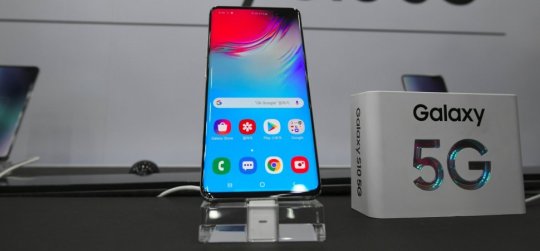
As previously mentioned, Samsung unveiled its second 5G phone, the Note 10 Plus 5G. It's pretty much identical to the regular Note 10 Plus but connects to 5G networks. It will be available on the US carrier Verizon first for $1,300 and will be in stores on Aug. 23. However, it may not be worth investing in this phone just yet. Meanwhile, Samsung's first 5G phone, the Galaxy S10 5G, is out right now. It has a 6.7-inch display, four rear cameras and the ability to wirelessly charge other devices. The device is available on Verizon, Sprint and T-Mobile, as well as AT&T but only for businesses. Samsung's foldable Galaxy Fold will have a 5G variant, too, but that phone's launch has been delayed until September due to reported screen issues that the company said it recently solved.
Google

Google hasn't revealed its plans for 5G, and the company declined to reply to a request to comment. What we do know is that Verizon is continuing its plans to roll out its 5G network in early 2019, similar to other carriers. What does that have to do with Google exactly? For the past few years, and for better or for worse, Google has tapped Verizon as its exclusive carrier partner for its Pixel phones, including its last flagship, the Pixel 3 and Pixel 3 XL. (However, Google also sells the phone unlocked or on its Wi-Fi-first network, Google Fi. Its most recent midrange phone, the Pixel 3A, and Pixel 3A XL are also now available from other carriers.) This could mean that its next flagship, which Google confirmed will be the Pixel 4 (and Pixel 4 XL), which could be a 5G phone. If it sticks with its usual phone launch schedule, the Pixel 4 would debut around October 2019 -- well after the first half of the year.
LG

The LG V50 ThinQ 5G is available to Sprint users for $1,152 and Verizon customers for $1,000. Sprint's 5G network is live in four cities: Dallas, Houston, Kansas City, and Atlanta. As mentioned earlier, we tested Sprint's 5G network in Dallas with the V50 and coverage was more consistent but slower than Verizon's. Sprint will also flip the switch for a handful of other cities afterward, like Los Angeles, New York and Washington, D.C. later in 2019. (FYI, Sprint is also expected to merge with T-Mobile soon, a move that carrier speed analyst Ookla said "could result in an unmatched network in the face of 5G.") The V50 will also be sold by T-Mobile and AT&T later in the year. The phone features a 6.4-inch OLED display, three rear cameras that include a wide-angle and telephoto lens, the Snapdragon 855 chipset and two front-facing cameras. It can also attach to a Dual Screen accessory that increases the phone's display size, though that won't be available in the US.
Lenovo/Motorola
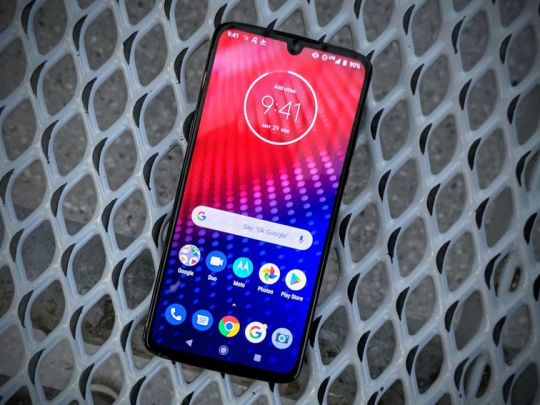
Lenovo's first 5G device was 2018's Motorola Moto Z3. Its successor, the Moto Z4, launched in May without much fanfare. Like the Z3, the Z4 connects to 5G with a Moto Mod modular accessory, which attaches to the back of the phone using magnetic pins. The phone is $499 and the Mod costs extra, but for a limited time, you can get both for $440, making the Z4 the cheapest 5G phone yet. When we first tested Verizon's 5G network with the Z3 and Mod in April, Jessica Dolcourt noticed "theoretical download speeds kissing 600Mbps." But other times, "The download would start strong, the phone would flicker to show the 4G logo, and speeds would plummet." As for a Motorola phone that wouldn't need an accessory to connect to 5G, the company is working on making such a device, but you'll have to wait much longer. Doug Michau, Motorola Mobility's director of technical sales and operations, said that phone would come much later than early 2019. More specifically, Michau said it would launch in "definitely less than three years, but no time frame yet."
Huawei

Chinese phone-maker Huawei has two 5G phones waiting in the wings. One is the Mate X, which combines 5G speeds and a foldable display. The device has a 6.6-inch display when folded closed, and an 8-inch OLED screen when you flip it open. It also features a 4,500-mAh battery and three rear cameras. The Mate X is scheduled to launch in the middle of the year and will cost a whopping 2,300 euros (about $2,600). Its second phone is the Mate 20 X 5G. The phone was supposed to launch in the UK in June for £999 (or about $1,279 in the US and AU$1,856 in Australia) but UK carriers EE and Vodafone have dropped plans to sell the device. The phone has a huge 7.2-inch display, a 4,200mAh battery, and a triple rear-camera setup. Don't expect these phones to come to the US, though. Calling it a security threat to the Department of Defense, the US government banned the sale of Huawei phones on US military bases. In May, an executive order put limits on foreign involvement in the US' carrier networks, which Huawei said will leave the US behind in 5G. Retail giant Best Buy also stopped selling Huawei products in March 2018 and Huawei's CFO was arrested in Canada at the request of the US in an act her father said was politically motivated. Italy also wants to ban the company from supplying 5G equipment. That doesn't necessarily spell the end of Huawei and its 5G ambitions, though. "Our products and solutions are used by major carriers, Fortune 500 companies and hundreds of millions of consumers in more than 170 countries around the world," a Huawei spokesman said last March. "We have earned the trust of our partners across the global value chain."
OnePlus

OnePlus' latest phone, the OnePlus 7 Pro, has a 5G variant that currently sells on UK carrier EE's 5G network. The OnePlus 7 Pro earned CNET's Editors' Choice Award and features a 6.67-inch, 90Hz display, a pop-up selfie camera, and three rear cameras. (It also survived a few dunk tests for water resistance, despite not being IP rated.) EE's 5G deployment will also span 16 cities in 2019, starting with London, Cardiff, Edinburgh, Belfast, Birmingham, and Manchester. OnePlus is working on bringing a 5G phone to the US though. On Aug. 6 the company announced it was partnering with Sprint to release a 5G phone "soon." In the meantime, the no-5G version of the OnePlus 7 Pro is available through T-Mobile, but unlocked models work on AT&T and Verizon. The regular OnePlus 7 Pro starts at $669 and £649 (converted, that's about AU$962 in Australia).
Nokia
Though Nokia isn't the phone giant that it was 15 years ago, it's still taking steps toward a 5G future. It's currently working with Qualcomm to make 5G devices and in July, the company announced a $3.5 billion partnership with T-Mobile, which includes taking advantage of T-Mobile's 600MHz spectrum to back its 5G network. But don't expect 5G Nokia phones anytime soon; in February HMD CEO Florian Seiche (who makes Nokia phones) said those devices probably won't arrive until 2020. Nokia also stands to benefit from 5G in other ways though. In addition to Qualcomm and Ericsson, the company has patent rights to 5G technology and stands to make up to $3.50 for every 5G smartphone sold.
HTC
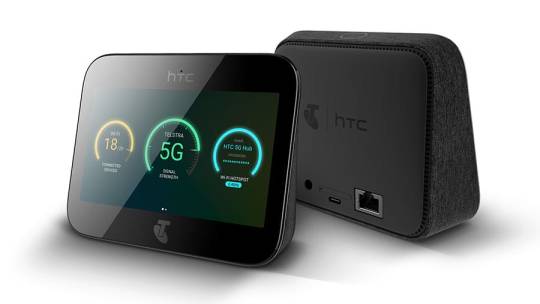
Instead of a phone, Taiwanese electronics company HTC has a 5G hotspot. Available now on Sprint for $600, the hub connects up to 20 people simultaneously. Equipped with a 5-inch display, audio speakers and Android Pie software, the device is also a media hub that users can make video calls with or use to check the mail.
ZTE
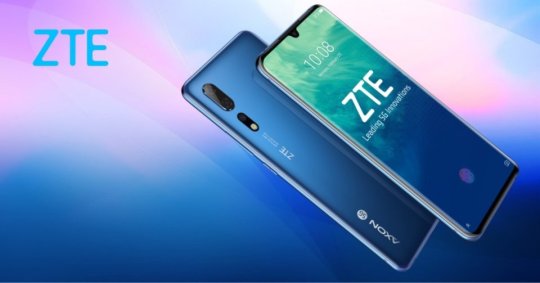
Scheduled to release in China and Europe, ZTE's Axon 10 Pro 5G has a 4G version that is already available in Germany for 599 euros ($671, £520, AU$967). It's equipped with a Snapdragon 855 processor and has a fingerprint scanner embedded in its screen. On the back are three cameras that have AI capabilities, including scene recognition. The rear setup includes a wide-angle camera, a standard lens, and a third telephoto camera. For your selfie shots, the front of the phone has a 20-megapixel camera. In February ZTE said it was aiming to have 5G phones off the ground in either late 2018 or early 2019, but followed that up with a "late 2019" prediction. Currently, ZTE is working with eight international carriers to roll out 5G testing. For now, the future of ZTE in the US is up in the air due to a recent (now lifted) ban on its phones because the company violated trade sanctions.
Xiaomi
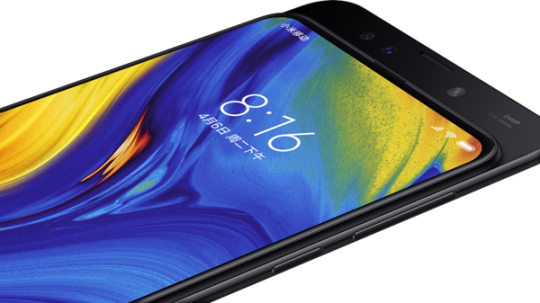
Chinese phone-maker Xiaomi remixed its Mi Mix 3 with a 5G model. Aptly named Mi Mix 3 5G, the phone costs 599 euros (about $679). It's unlikely that the phone will be available in the US. The company's initial 5G network partners include many European carriers, including Orange, Sunrise, Telefonica, Three, TIM and Vodafone -- the last of which will exclusively carry the Mi Mix 3 5G first. The phone itself features a 6.39-inch AMOLED display, a Snapdragon 845 processor and dual 12-megapixel rear cameras. Calling it "almost the perfect phone," CNET editor Aloysius Low also mentioned that it's neither water-resistant nor do its front-facing cameras have secure 3D face unlocking.
Oppo
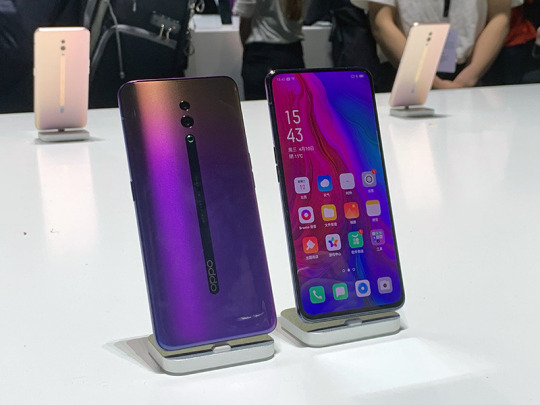
After showing off a prototype at MWC 2019, OnePlus' sister company Oppo debuted its trio of Oppo Reno phones in April. One of the phones includes a 5G model, the Oppo Reno 5G, which is available on the UK carrier EE and Australia for AU$1,499. The device features a fantastic 6.6-inch screen, a Snapdragon 855 chipset and a pop-up selfie camera. In addition to EE and Australia's Telstra and Optus, Oppo is working with Swisscom, as well as Singtel in Singapore, to launch the phone. It's also partnering with China Mobile to sell the phone later this summer. Read the full article
0 notes
Text
Last Week’s Workouts
Last week’s workouts
Monday
30 minutes Arc Trainer
20 minutes Stepmill
strength training
DB bench press
DB pull over
Bench step ups w/ shoulder press
Bench plank rows w/ leg lift
Cable single leg reach and pull
TRX single leg row
Eccentric pull ups
Banded assisted pull ups
TRX lunges
TRX pike planks
TRX single leg mountain climbers
Tuesday
Morning Flow Yoga @ Bending Bodhi
7 mile run, 9:29 avg/pace, 442 ft elev/gain
My friend and training partner from last year, Lori, was in town so we hit the roads dark and early just like old times. She’s training for the Vermont 100 so we stuck to an easy pace with some hills thrown in for fun. It was great to catch up but I could have done without the bun freezing temp of 15 degrees. Happy first day of spring!
This pic is from a 12 mile trail run in January last year. Did I mention I did it without spikes and was absolutely dying at the end?

Wednesday
20 minutes Arc Trainer
20 minutes Stepmill alternating front, side, and double steps
strength training
Cable push press
Eccentric pull ups
Banded assisted pull ups
Pull up shrugs
TRX pistol squats
Bench step ups with shoulder press
Front to reverse lunges
Side lunge push press
TRX pike planks
Thursday
Morning Flow Yoga
10 mile Tempo Run: 2 miles easy w/u, 4 x 1 mile @ 7:45-7:50 (reality 7:33-7:49), 2+ easy miles c/d, 8:24 avg/pac, 220 ft elev/gain
That was the plan but I made many mistakes about this run.
First, I did it in the middle of the day when the predicted Nor’easter was winding down (but really wasn’t a big deal at all). I had a small snack before hand but my stomach started to growl 4 miles into the run.
Second, I was too obsessed with my watch rather than my effort for pacing. My watch was saying I was running way slower than I was aiming for so I picked up the pace. When the mile beeped, I was a good 15-20 seconds faster than I had intended for the first 3 mile repeats. I finally stopped looking at my watch for the fourth repeat and went with effort which had me right on target.
Third, running the last 5 miles into a headwind and being mostly forced to run in slushy snow on the shoulder of the road because of traffic made me extra grumpy and hungry.
I spent the last few miles of the run dreaming of what I’d eat once I got home. As soon as I did get home, I knew something was wrong. Cooper was not at the door to greet me and I smelled poop. I’m sure I stunk but not of shit.

I followed the smell of poo and ended up outside of the bathroom door.
Side note: Cooper is 12 years old and just realized that we have a garbage can. We’ve since had to close up the kitchen garbage into the bathroom every time we go somewhere.
I opened the bathroom door and Cooper popped out, excited to see me and thrilled to be free. As I opened the door further, I was met with the most horrible smell ever. Apparently, Cooper got scared shitless that he was locked in the bathroom. He then proceeded to step in it and spread the poop ALL over the bathroom.
Sigh.
Let’s just say my bathroom is so stinkin’ clean now that I could have eaten off the floor if I wanted to. I didn’t. But I could have when I finally was able to eat what I had been dreaming of devouring during my run.
Running and pets are fun.
Friday
6.6 mile run, 8:58 avg/pace, 332 ft elev/gain
Easy miles with Kyle to kick off Friday. I love our early morning runs because we solve the world’s problems. Or at least we think we do!
Saturday
I slept horribly for most of the week and was feeling it Saturday morning. I had planned on doing some sort of workout before the days events kicked off but I opted for more sleep. And then I spent the rest of the day snuggling baby bunnies, ducks and goats. How cute is this two day old baby?!?!
Sunday
7 mile run, 8:52 avg/pace, 374 ft elev/gain
Another bun freezing morning run with a headwind that would not give up. C’mon spring…can you at least give us 50 degrees?
A strong week of running + cross training with a side of life with pets. #runchat #run #workouts Click To Tweet
Linking up with Hoho and Wendy for the weekly workout wrap up.
How was your week in workouts?
The post Last Week’s Workouts appeared first on Happy Fit Mama.
from Happy Fit Mama https://ift.tt/2GsSMBO
0 notes
Text
Proptech’s Q2 2020 Earnings Radar
The (second quarter) results are in for proptech’s public companies in 2020. We’re trying something new: synthesizing the most relevant topline information from the sector’s financial reports and balance sheets. It’s safe to say the market remains robust during this time of uncertainty, but the underlying message of “proceed with caution” isn’t lost on us…
COMPANY SNAPSHOTS
Zillow reported a strong second quarter, with its total consolidated revenue growing 28% year over year to $768 million. With Zillow’s stock price nearly doubling since a slump in February, Zillow really is the trailblazer in the sector and has the numbers to back it up.
Notable takeaways:
Its Homes segment delivered $454 million in revenue. That’s up 82% compared to this time last year, but a drop of more than 40% from Q1 ($769,873).
Premier Agent year-over-year revenue decreased 17% to $192 million, primarily due to the impact of COVID-19.
Traffic to Zillow Group’s mobile app and websites reached a record 218 million average monthly unique users.
The company exited the quarter with its highest cash balance in history, growing cash and investments from $2.6 billion to $3.5 billion.
Learn more: full press release // Notorious Rob // Inman.
Newscorp’s business has clearly been struck by COVID-19, with revenues declining by $1.92 billion, a 22% drop compared to $2.47 billion in the prior year. Move, (operator of realtor.com), reported an increase in its profit contribution in the fourth quarter and saw record traffic in June, with over 30% growth in unique users.
Notable takeaways:
Net loss for the quarter was $401 million compared to $42 million the prior year, reflecting $292 million of non-cash impairment charges, primarily related to fixed assets in the U.K. and Australia, higher restructuring costs due to COVID-19, and lower Total Segment EBITDA.
Newscorp reported fourth quarter Total Segment EBITDA of $195 million, a 28% decline compared to $269 million in the prior year.
Net loss per share attributable to News Corporation stockholders was $(0.67) as compared to $(0.09) in the prior year.
Realtor.com reported a decline in revenue of 10 percent year over year, to $111 million.
For 2020, Move’s real estate revenues, which represented 81 percent of all Move revenues, increased 2 percent from FY 2019. [SOURCE]
News Corp.’s digital real estate services segment saw revenues decrease 4 percent year-over-year from $272 million to $261 million in Q2 2020. [SOURCE]
Learn more: Press release // Notorious Rob // Inman.
Redfin’s revenue increased 8% year over year to $214 million during the second quarter, as CEO Glenn Kelman remarked that the company “blew away” its quarterly targets. He added a note of caution about the market’s “tornado” like volatility and remarked that Redfin is “mindful that the bottom of the economy could fall out a second time.”
Notable takeaways:
Operating expenses were $50 million, a decrease of 17% from $61 million in Q1.
Net loss was $6.6 million compared to $12.6 million in Q2 in 2019.
Redfin reached market share of 0.93% of existing U.S. home sales by value in Q2.
Learn more: Press release // Notorious Rob // Inman
RE/MAX reported a near $20 million dollar decrease in revenue compared to the second quarter of 2019—its $52.2 million Q2 2020 revenue represents a 26.9% drop from $71.4 million in Q2 2019. CEO Adam Cantos cited the “strength” of RE/MAX’s business model as why he believes they weather the impact of COVID-19 and continue to expand their value proposition.
Notable takeaways:
Total agent count increased by 3.8% (in comparison to Q2 2019) to 131,905.
RE/MAX’s recurring revenue streams (which consist of continuing franchise fees and annual dues) decreased $8.2 million compared to the second quarter of 2019 and accounted for 63.0% of revenue.
Adjusted basic and diluted EPS were each $0.38 compared to $0.65 per share each for the second quarter of 2019.
Adjusted EBITDA was $18.9 million for the second quarter of 2020, a decrease of $11.0 million or 36.7% from the second quarter of 2019.
Learn more: Press release // Notorious Rob // Inman
eXp World Holdings reported its most profitable quarter in the company’s history with net income of $8.3 million in the second quarter. Quarterly revenue also grew 33% year over year to $354 million due largely to its strength in agent count and transactions. Worth noting its cloud-based model operating on VirBELA, a platform perfectly suited to the socially distanced landscape that brokerages are now competing in.
Notable takeaways:
Net income was $8.3 million, or $0.11 per diluted share in the second quarter of 2020, compared to a net loss of $2.2 million, or $0.04 per diluted share, in the second quarter of 2019.
Adjusted EBITDA (a non-GAAP financial measure) was $13.6 million in the second quarter of 2020, compared to $3.8 million in the second quarter of 2019.
Cash flow from operations increased 57% to $28.5 million in the second quarter of 2020, compared to $18.1 million in the second quarter of 2019.
Learn more: Press release // Notorious Rob // Inman
Realogy’s message was a stoic one as CEO Ryan Schenider remarked on their efforts to “enhance” their digital tech offerings and investment in “strategic priorities.” It’s clear the turbulent environment has impacted on Realogy’s revenue but their team has taken proactive steps to strengthen the company’s balance sheet.
Notable takeaways:
Realogy generated Revenue of $1.2 billion, a decrease of 27% or $457 million year-over-year.
The GRA mortgage JV continued to contribute meaningfully to Realogy’s business results, generating $35 million in Operating EBITDA in the second quarter.
The company strengthened the balance sheet and improved its debt maturity profile by refinancing its 2021 unsecured notes with new 2025 senior secured second-lien notes.
Learn more: Press release // Notorious Rob // Inman
CoStar reported impressive revenue increases, up 16% year over year. A record sales month, $2.7 billion dollars raised in the equity and debt market and the acquisition of Ten-X are clear indicators of results that founder and CEO Andrew C. Florance describes as “countercyclical.” He also remarked on a13% increase in unique monthly users visiting Apartments.com and LoopNet marketplaces compared to Q1 (55 million users).
Notable takeaways:
Revenue was $397 million, an increase of 16% over the $344 million for Q2 of 2019.
Net income for the second quarter of 2020 was $60 million, or $1.60 per diluted share.
Adjusted EBITDA was $129 million, an increase of 17% compared to adjusted EBITDA of $110 million for the second quarter from a year ago.
Learn more: Press release // The Real Deal
MARCHING FORWARD
With a number of these companies reporting impressive revenue and earnings, it’s clear that the real estate markets navigated the pandemic incredibly well. Notable trends for a number of these companies include the growth in online traffic, alongside impressive adjusted EBITDA numbers. The undoubted optimism that exists continues to buoy the sector, but it’s clear that a sense of caution remains important in such a volatile period for the market. Despite the nationwide impact of the pandemic, the market remains a stalwart of the American economy—the basic fact that people must continue to pay rent and mortgages means our industry will continue drumming along.
The post Proptech’s Q2 2020 Earnings Radar appeared first on GeekEstate Blog.
Proptech’s Q2 2020 Earnings Radar published first on https://thegardenresidences.tumblr.com/
0 notes
Text
Proptech’s Q2 2020 Earnings Radar
The (second quarter) results are in for proptech’s public companies in 2020. We’re trying something new: synthesizing the most relevant topline information from the sector’s financial reports and balance sheets. It’s safe to say the market remains robust during this time of uncertainty, but the underlying message of “proceed with caution” isn’t lost on us…
COMPANY SNAPSHOTS
Zillow reported a strong second quarter, with its total consolidated revenue growing 28% year over year to $768 million. With Zillow’s stock price nearly doubling since a slump in February, Zillow really is the trailblazer in the sector and has the numbers to back it up.
Notable takeaways:
Its Homes segment delivered $454 million in revenue. That’s up 82% compared to this time last year, but a drop of more than 40% from Q1 ($769,873).
Premier Agent year-over-year revenue decreased 17% to $192 million, primarily due to the impact of COVID-19.
Traffic to Zillow Group’s mobile app and websites reached a record 218 million average monthly unique users.
The company exited the quarter with its highest cash balance in history, growing cash and investments from $2.6 billion to $3.5 billion.
Learn more: full press release // Notorious Rob // Inman.
Newscorp’s business has clearly been struck by COVID-19, with revenues declining by $1.92 billion, a 22% drop compared to $2.47 billion in the prior year. Move, (operator of realtor.com), reported an increase in its profit contribution in the fourth quarter and saw record traffic in June, with over 30% growth in unique users.
Notable takeaways:
Net loss for the quarter was $401 million compared to $42 million the prior year, reflecting $292 million of non-cash impairment charges, primarily related to fixed assets in the U.K. and Australia, higher restructuring costs due to COVID-19, and lower Total Segment EBITDA.
Newscorp reported fourth quarter Total Segment EBITDA of $195 million, a 28% decline compared to $269 million in the prior year.
Net loss per share attributable to News Corporation stockholders was $(0.67) as compared to $(0.09) in the prior year.
Realtor.com reported a decline in revenue of 10 percent year over year, to $111 million.
For 2020, Move’s real estate revenues, which represented 81 percent of all Move revenues, increased 2 percent from FY 2019. [SOURCE]
News Corp.’s digital real estate services segment saw revenues decrease 4 percent year-over-year from $272 million to $261 million in Q2 2020. [SOURCE]
Learn more: Press release // Notorious Rob // Inman.
Redfin’s revenue increased 8% year over year to $214 million during the second quarter, as CEO Glenn Kelman remarked that the company “blew away” its quarterly targets. He added a note of caution about the market’s “tornado” like volatility and remarked that Redfin is “mindful that the bottom of the economy could fall out a second time.”
Notable takeaways:
Operating expenses were $50 million, a decrease of 17% from $61 million in Q1.
Net loss was $6.6 million compared to $12.6 million in Q2 in 2019.
Redfin reached market share of 0.93% of existing U.S. home sales by value in Q2.
Learn more: Press release // Notorious Rob // Inman
RE/MAX reported a near $20 million dollar decrease in revenue compared to the second quarter of 2019—its $52.2 million Q2 2020 revenue represents a 26.9% drop from $71.4 million in Q2 2019. CEO Adam Cantos cited the “strength” of RE/MAX’s business model as why he believes they weather the impact of COVID-19 and continue to expand their value proposition.
Notable takeaways:
Total agent count increased by 3.8% (in comparison to Q2 2019) to 131,905.
RE/MAX’s recurring revenue streams (which consist of continuing franchise fees and annual dues) decreased $8.2 million compared to the second quarter of 2019 and accounted for 63.0% of revenue.
Adjusted basic and diluted EPS were each $0.38 compared to $0.65 per share each for the second quarter of 2019.
Adjusted EBITDA was $18.9 million for the second quarter of 2020, a decrease of $11.0 million or 36.7% from the second quarter of 2019.
Learn more: Press release // Notorious Rob // Inman
eXp World Holdings reported its most profitable quarter in the company’s history with net income of $8.3 million in the second quarter. Quarterly revenue also grew 33% year over year to $354 million due largely to its strength in agent count and transactions. Worth noting its cloud-based model operating on VirBELA, a platform perfectly suited to the socially distanced landscape that brokerages are now competing in.
Notable takeaways:
Net income was $8.3 million, or $0.11 per diluted share in the second quarter of 2020, compared to a net loss of $2.2 million, or $0.04 per diluted share, in the second quarter of 2019.
Adjusted EBITDA (a non-GAAP financial measure) was $13.6 million in the second quarter of 2020, compared to $3.8 million in the second quarter of 2019.
Cash flow from operations increased 57% to $28.5 million in the second quarter of 2020, compared to $18.1 million in the second quarter of 2019.
Learn more: Press release // Notorious Rob // Inman
Realogy’s message was a stoic one as CEO Ryan Schenider remarked on their efforts to “enhance” their digital tech offerings and investment in “strategic priorities.” It’s clear the turbulent environment has impacted on Realogy’s revenue but their team has taken proactive steps to strengthen the company’s balance sheet.
Notable takeaways:
Realogy generated Revenue of $1.2 billion, a decrease of 27% or $457 million year-over-year.
The GRA mortgage JV continued to contribute meaningfully to Realogy’s business results, generating $35 million in Operating EBITDA in the second quarter.
The company strengthened the balance sheet and improved its debt maturity profile by refinancing its 2021 unsecured notes with new 2025 senior secured second-lien notes.
Learn more: Press release // Notorious Rob // Inman
CoStar reported impressive revenue increases, up 16% year over year. A record sales month, $2.7 billion dollars raised in the equity and debt market and the acquisition of Ten-X are clear indicators of results that founder and CEO Andrew C. Florance describes as “countercyclical.” He also remarked on a13% increase in unique monthly users visiting Apartments.com and LoopNet marketplaces compared to Q1 (55 million users).
Notable takeaways:
Revenue was $397 million, an increase of 16% over the $344 million for Q2 of 2019.
Net income for the second quarter of 2020 was $60 million, or $1.60 per diluted share.
Adjusted EBITDA was $129 million, an increase of 17% compared to adjusted EBITDA of $110 million for the second quarter from a year ago.
Learn more: Press release // The Real Deal
MARCHING FORWARD
With a number of these companies reporting impressive revenue and earnings, it’s clear that the real estate markets navigated the pandemic incredibly well. Notable trends for a number of these companies include the growth in online traffic, alongside impressive adjusted EBITDA numbers. The undoubted optimism that exists continues to buoy the sector, but it’s clear that a sense of caution remains important in such a volatile period for the market. Despite the nationwide impact of the pandemic, the market remains a stalwart of the American economy—the basic fact that people must continue to pay rent and mortgages means our industry will continue drumming along.
The post Proptech’s Q2 2020 Earnings Radar appeared first on GeekEstate Blog.
from RSSMix.com Mix ID 8230574 https://ift.tt/2DPJfWh via IFTTT
0 notes
Text
Android best with 4G technologies.
Galaxy TwistThis ain't your grandma's flip phone (Image Source: Huawei)The Google Pixel 4 show is the upgraded version of the Google Pixel 3 XL from Google. Last year, Google officially announced the Pixel 3 and Pixel 3 XL in early October, and they published the mobiles soon thereafter (around October 18). So, should they maintain the exact same schedule this season it ought to be on the shelves in mid-October.The Samsung Galaxy Notice 10 series cost range is anticipated to cost between $1,000 and $1,100, according to the Yonhap news agency.Here's a listing of the foldable phones available this 2019:3-D leaves based off Motorola's patent (Picture Resource: Yanko Design)The Huawei Mate X is your flagship foldable telephone from Huawei. The company said that the Mate X won't be released based on CNBC.Google has recently released a teaser about which the Pixel 4 will be anticipated to appear like and there are a great deal of theories in flow regarding those pictures.The innovative design includes a 7.3-inch tablet with Infinity Flex Display when it's opened. When it is consumed, it has a 4.6-inch screen that is fantastic for one-handed use. Samsung asserts they tested their telephone using a system that started and shut 2,000 times to the model.Google leaked an image of its phone in June (Picture Source: Produced by Google)The Huawei Mate 30 series cost range is expected to cost between $1,000 and $1,200.2. Huawei Mate 30 and Mate 30 GuruThe Mate X opens as an 8-inch tablet then folds into a 6.6-inch smartphone. When it's folded the design is slimmer than the Samsung Galaxy Fold. It will run on the Kirin 980 processor.The Samsung Galaxy Fold is the flagship foldable phone from Samsung. The company has since pushed the release date back, although it was scheduled to be published in April. While they haven't announced an official release date, it is expected to be published after the Galaxy Notice 10.To learn more, be sure to check out our review on the Samsung Galaxy Fold.5. Samsung Galaxy Fold It is a mid-range smartphone that has enhanced features from the predecessor.The Motorola Razr mobile phone is an updated version of the MotoZ4. It resembles a phone back to the Motorola Razr phone. Instead of a numeric keypad, the Motorola Razr foldable phone is going to have a 6.2-in OLED (or organic light-emitting diode) screen with a secondary external display. It is going to be among the foldable telephones to be published combined with people in Huawei and Samsung.By what we have observed, 2019 is a competitive year for Android devices, together with flagship devices trying to outdo one another. You would like it to be installed correctly, and if you bought a new Android cellphone, you have them do it for you, and can contact the professionals at HelloTech. The Samsung Galaxy Notice 10 is an improved version of its predecessor, the Galaxy Note 9. There are three distinct Samsung Note 10 versions which are scheduled to be published in 2019: the Samsung Notice also the Note 10 +, the 10 Lite, and 10. You can anticipate 5G compatibility at the Note 10 and Note 10+. Together with the Support of all Samsung DeX, the Note 10 is said to function as PC a smartphone, and a laptop. This usually means you'll never have to carry your laptop on a business trip.It is a telephone. No, it's a pill. Using the Galaxy Fold, you get the best of both worlds (Image Resource: Samsung)This can be the year when businesses try to innovate by producing full-OLED foldable telephones. While the Android device could not be simpler compared to the manufacturing cost of these devices, companies are investing in the foldable phone concept.The Motorola Razr foldable telephone cost is expected to cost approximately $1,500.The typical Notice 10 is expected to possess a 6.28-inch display, along with also the Note 10+ is predicted to possess a 6.75-inch screen. The 8-megapixel camera will probably be in the upper portion of the display, and a quad-camera (together having three really are aligned vertically) will likely be in the rear portion of the telephone. The back cameras are a, also a, a telephoto lens. Pocophone F2ConclusionThe Huawei Mate X is anticipated to cost approximately $2,600, which would make it even more costly than the Samsung Galaxy Fold.It is expected to cost around $1,900 to $2,200, making it among the priciest smartphones in the marketplace these days.There are rumors regarding how it will look, however until their unveiling, the majority of those are speculation. Is the fact that it's going to be greater.The Pocophone F2 is the updated version of the Pocophone F1 out of Xiaomi. It is scheduled to be published in the second half 2019. Many expect the new version to be published about August 2019 Considering that the Pocophone F1 premiered in August of 2018.6. Huawei Mate XThe Huawei Mate 30 and Mate 30 Pro will be the updated versions of this Huawei Mate 20. They are scheduled to be published in the second half of 2019, but many news sources are saying that it will be in October. Motorola Razr telephone that is foldableThe Xiaomi Pocophone F2's price is anticipated to cost around $450.3. Google Pixel 4 string
0 notes